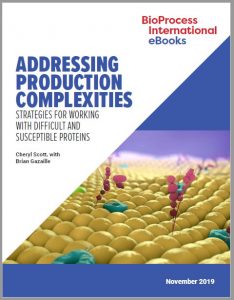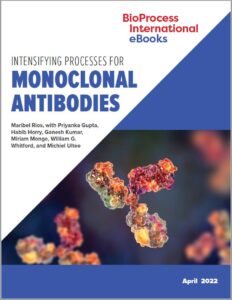 Intensifying Processes for Monoclonal Antibodies
Intensifying Processes for Monoclonal Antibodies
The commercial manufacturing success of monoclonal antibodies (MAbs) has become a touchstone of the biopharmaceutical industry. MAbs are so well established that they often are referred to as “traditional” biologics, and well-known MAb processing methods have become a model for processing of other “advanced” or “emerging” therapies. But MAb processing continues to advance as biomanufacturers seek ways to improve efficiencies, lower costs, and (most recently) increase sustainability of facilities. Drug makers are particularly interested in strategies for MAb process intensification. In the biopharmaceutical industry, intensification historically has been synonymous with implementation of perfusion-mode bioreactor systems. But as this eBook shows, MAb process intensification has expanded to involve all bioprocess unit operations — and even entire production facilities. Herein, BPI’s managing editor reports on her discussions with several industry experts about new approaches to intensification. The contributors call attention to several drivers for current intensification efforts. They also describe regulatory supports for manufacturing innovations, advances in protein expression systems (and their implications for intensification efforts), considerations for multicolumn chromatography and other downstream unit operations, and requirements for the analytics that are needed to monitor and control new processes.
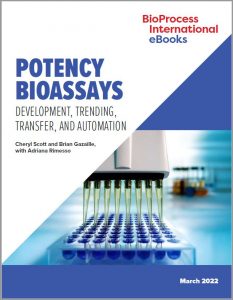 Potency Bioassays: Development,
Potency Bioassays: Development,
Trending, Transfer, and Automation
Bioassay development is a complex process that must be undertaken with great rigor and attention to detail. Potency testing experts use a range of methods including cell-based and binding assays. Consistency and reliability of results over time are paramount. Well-developed and -characterized methods are the end result of much phase-appropriate development work that goes on in parallel with bioprocess and biotherapeutic product development. This eBook begins with BPI senior technical editor Cheryl Scott’s report from the Biopharmaceutical Emerging Best Practices Association’s 2022 bioassay conference. The virtual event, held on 21–24 March 2022, featured several presentations about the obstacles associated with potency assays for gene therapies based on adenoassociated virus (AAV) vectors and for chimeric antigen receptor (CAR) T-cell therapies. Presenters also explored strategies for determining system suitability and for analyzing and trending data generated by cell-based potency assays. The eBook concludes with an in-depth discussion about bioassay development between BPI associate editor Brian Gazaille and Adriana Rimesso, an analytical development scientist at Biogen. Rimesso addresses practical concerns for developing, qualifying, and validating cell-based assays. She also highlights the value of cross-departmental collaboration, especially when transferring analytical methods across teams and sites and when evaluating bioassay accuracy and precision.
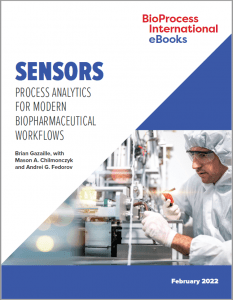 Sensors: Process Analytics for
Sensors: Process Analytics for
Modern Biopharmaceutical Workflows
To achieve quality by design in biopharmaceutical production, manufacturers need tools that can ensure the stability of critical process parameters (CPPs) and other performance indicators related to product critical quality attributes (CQAs). Over the past couple of decades, sophisticated process analytical technologies (PATs) have emerged to address such needs. Offerings are now abounding for single-purpose sensors that measure temperature, pressure, pH, glucose, protein concentration, or dissolved oxygen. New in-line formats are enabling such instruments to provide data in real time, bringing manufacturers of monoclonal antibodies and other protein products closer than ever before to the goal of adaptive process control. But much work remains to be done regarding process analytics for cell therapies and other emerging biopharmaceutical modalities.
This eBook maps out the current PAT landscape, gauging remaining needs for modern biopharmaceutical workflows. BPI’s associate editor speaks with the founders of Andson Biotech, a newly launched PAT developer, to learn why commercially available sensors and other PATs suffice for many conventional upstream processes but not for production of complex proteins or advanced therapies. The discussion emphasizes developers’ needs for tools that can monitor more specific parameters, which in turn could provide more meaningful information about process and product quality. Read the eBook to learn about such needs and about emerging solutions such as Andson Biotech’s technologies for real-time mass spectrometric analysis of biomolecules.
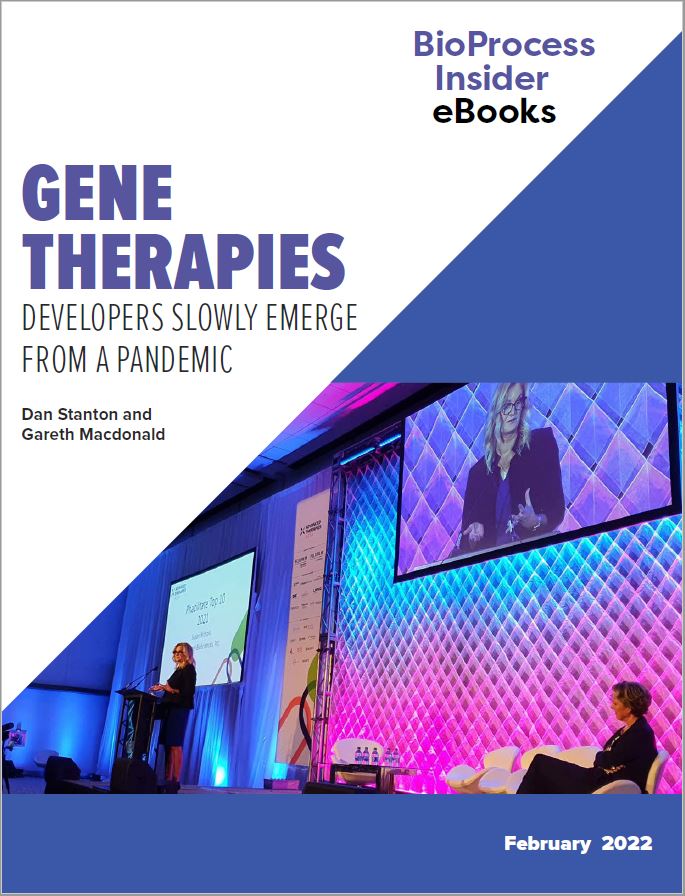 Gene Therapies: Developers
Gene Therapies: Developers
Slowly Emerge from a Pandemic
This BioProcess Insider eBook gauges shifting expectations for the gene therapy industry amid the COVID-related uncertainties and clinical setbacks of the past couple years. BioProcess Insider founding editor Dan Stanton reports on the January 2022 Phacilitate Advanced Therapies Week event, specifically a standing presentation on the 10 most important industry drivers from the past year. Since 2017, advancements in gene therapies have featured prominently in these presentations. In 2021, gene therapies again made the list, but this time for more troubling reasons, including reduced capacity, product development setbacks, adverse events in clinical trials involving AAV-based candidates, and other factors that have failed to bring greater numbers of gene therapies into commercialization. Stanton demonstrates, however, that the industry appears to be gaining optimism in 2022, driven by the high number of gene-therapy candidates progressing through clinical trials. Next, Stanton reports on the most recent strategies of Big Pharma companies Novartis and Pfizer. Their approaches rely on internal capabilities, heavy investments, next-generation technologies, and platforms that are designed to improve processes, shorten time to development, and reduce cost of goods sold. Finally, Insider contributor Gareth Macdonald offers insights gained from the fall 2021 BioProcess International Conference and Exhibition in Boston, MA, focusing on a presentation about the importance of incorporating analytical systems in process development and manufacturing facility design. Read the complete eBook to learn about how the gene therapy industry seeks to regain its momentum.
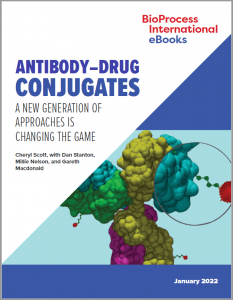 Antibody–Drug Conjugates: A New Generation
Antibody–Drug Conjugates: A New Generation
of Approaches Is Changing the Game
Combining large proteins with linkers and cytotoxins, antibody–drug conjugates (ADCs) may be the most complex drug molecules in development today. Despite early promise and product approvals, a number of technical concerns arose during product and process development. Characterizing and ensuring consistency in the number of small molecules that attach to the antibody — as well as ensuring their proper attachment and biophysics — all present significant challenges to ADC developers. Solving early problems associated with product quality has introduced a second generation of ADC development approaches into the drug pipeline.
This eBook explores the business trends and technical innovations that are helping second-generation ADCs to advance through clinical development and into the marketplace. First, reporters from the BioProcess Insider chronicle the many ADC-enabling acquisitions and collaborations from 2021. On the heels of recent regulatory approvals, biopharmaceutical companies continue to seek out discovery and manufacturing capabilities that will set them up for success in the ADC market. Then, BioProcess International‘s senior technical editor describes emerging platforms for ADC development and explores advances in ADC-product analysis and characterization. Read the eBook to learn more about these second-generation ADC development approaches and their implications for treating myriad forms of cancer.
 Diagnostics: Developing Rapid
Diagnostics: Developing Rapid
and Accessible Testing Solutions
The COVID-19 pandemic has brought myriad economic disruptions, social complications, and public-health calamities to the world. They have understandably overshadowed the silver lining of boosting biomedical science and technology in the realms of infectious disease, oncology, and more. But alongside the much-publicized commercial debut of novel vaccine technologies have come promising advances in medical diagnostics. In this eBook, BPI’s senior technical editor brings together perspectives from industry, academia, and expert organizations to highlight some of the latest diagnostic methods and to explore how the pandemic has affected their progress. As expected, recent advances have been driven primarily by the need for rapid results from accessible testing solutions. The eBook’s first chapter explores how novel label-free infrared imaging techniques, neutralizing antibody (NAb)-based assays, point-of-care test methods, breathalyzer testing, and even CRISPR-based methods seek to meet that need for COVID-19 detection. Next, a science editor from ETH Zurich describes newly developed polymers that could enable tunable fluorescence detection with potential applications in the field of biomedicine. Next comes discussion about the critical need for reference standards in diagnostic testing to ensure assay reproducibility. The eBook’s final chapter focuses on diagnostic testing solutions that could facilitate detection of the SARS-CoV-2 omicron variant. Read the eBook to learn how the evolving pandemic is accelerating significant advances in medical diagnostics around the world.
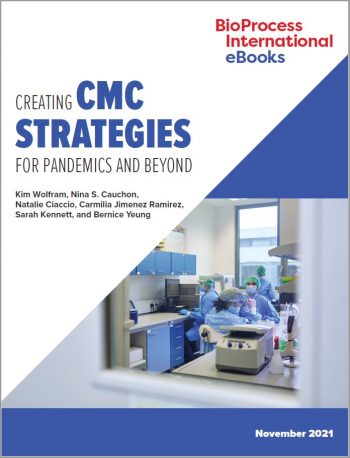 Creating CMC Strategies for Pandemics and Beyond: Perspectives on the Impact of the COVID-19 Pandemic
Creating CMC Strategies for Pandemics and Beyond: Perspectives on the Impact of the COVID-19 Pandemic
The COVID-19 novel coronavirus pandemic has highlighted the biopharmaceutical industry’s need to create and implement chemistry, manufacturing, and controls (CMC) strategies that can expedite drug development during times of crisis. This bold topic was the premise of the 2021 CASSS Well-Characterized Biotechnology Products (WCBP) forum titled “Special Edition: Creating CMC Strategies for Pandemics and Beyond.” Held virtually on 25–28 January and 1–4 February 2021, the eight-day event addressed manifold considerations for SARS-CoV-2 virus prevention, diagnosis, and treatment. Five hundred attendees representing 100 companies and academic organizations from across 15 nations grappled with how to manage the needs of the biopharmaceutical supply chain, repurpose existing drugs, apply prior knowledge, adapt traditional process development paradigms, leverage existing platform technologies, and accelerate technical transfers amid unprecedented requirements. In this eBook, WCBP leaders summarize key insights from the event’s presentations, panel discussions, and workshop groups. Read the eBook now to learn how CMC strategies for pandemics might shape — and perhaps accelerate — all future development activities for vaccines, conventional biologics, and protein-based diagnostics.
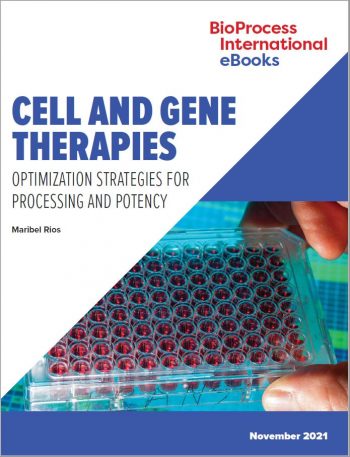 Cell and Gene Therapies: Optimization Strategies for Processing and Potency
Cell and Gene Therapies: Optimization Strategies for Processing and Potency
Although relatively new to the biopharmaceutical industry, cell and gene therapy development and manufacturing are advancing rapidly. At Informa Connect’s September 2021 Cell & Gene Manufacturing & Commercialization Conference and Exhibition, held in Boston and online, presentations reviewed concerns that arise when processing complex therapies and highlighted some innovative strategies for surmounting those obstacles. Most of those approaches described during the event used data-driven solutions, with each step building on the information gained from the previous one. High-throughput technology platforms are being designed to identify targets for solid cancers and shorten vein-to-vein timelines. Developers also are engineering hematopoietic stem cells that “uncouple” the target expression between healthy and cancer cells, thus enabling a therapy to kill only cancer cells. In this eBook, BPI managing editor Maribel Rios relates major insights from the September event. First, she focuses on a presentation describing implementation of mechanistic modeling and simulations to increase production of adenoassociated virus (AAV) vectors for use in gene therapy delivery. The second section of the eBook explores the difficulties associated with designing and performing potency assays for advanced therapy products. Such therapies are much more complex than they were even a decade ago, and knowledge to assess their functionality, activity, vector infectivity, and other parameters has not kept up with the pace of product development. Rios summarizes three presentations addressing potency assay design and workflows, including the implementation of specific analytical technologies during clinical development.
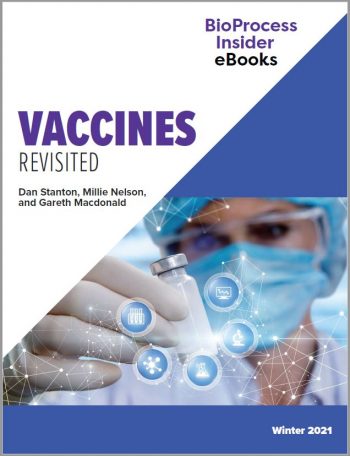 Vaccines Revisited: The Past, Present, and Future of Nucleic Acid Vaccine Production
Vaccines Revisited: The Past, Present, and Future of Nucleic Acid Vaccine Production
The quarterly BioProcess Insider eBook series launched in 2021 to investigate specific modalities and business strategies driving the biopharmaceutical sector based upon trends and discussion points presented in the Insider’s pages. Two of the four quarterly publications — this one included — have focused on the vaccine industry. If the series had launched in 2019, cell and gene therapies might have warranted a double edition, or perhaps investments in antibodies and antibody fragments would have driven a bispecific focus. Five or even 10 years ago, investments in the vaccine sector were limited, capacity expansions were rare, and the few new product approvals went mostly under the radar. Vaccines were the “backwaters” of the biopharmaceutical industry.
But the vaccine industry has surged in response to the novel coronavirus pandemic, fueled by considerable research and development (R&D) funding and driven by promising new modalities. The Insider’s February 2021 eBook examined the economic impact of COVID-19, the pipeline of vaccines against it, and some of the manufacturing issues surrounding those candidates. This follow-up focuses on the most successful vaccines to have emerged from the novel coronavirus pandemic. Clinical candidates and commercialized products based on nucleic acids take center stage. The eBook describes how research into mRNA and plasmid DNA vaccines began in the 1970s and 1980s, how such products finally have arrived in the arms of billions of people, and how nucleic-acid vaccine production could revolutionize healthcare subsequently.
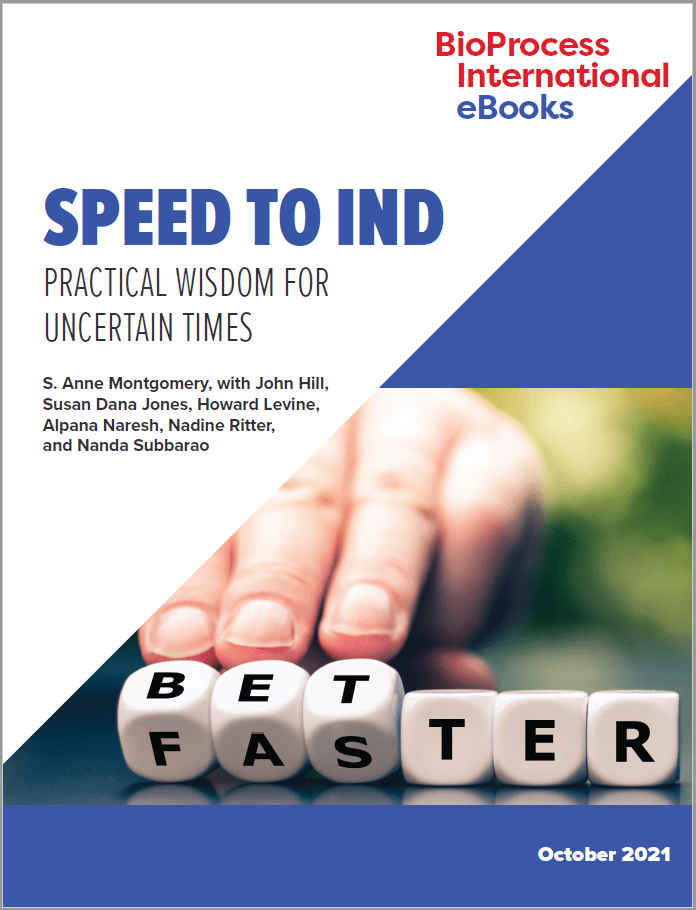 Speed to IND: Practical Wisdom for Uncertain Times
Speed to IND: Practical Wisdom for Uncertain Times
Even in “normal” times, companies need to balance time to filing an investigational new drug (IND) application against careful consideration of processes that can have far-reaching consequences on the quality of biologic products. But supply-chain interruptions still feature prominently in the news during the ongoing COVID-19 pandemic. From equipment to chemicals to plastic components, end users, their suppliers, and (critically) their suppliers’ suppliers all are feeling growing uncertainty about production timelines and availability of materials. In this eBook, BPI’s editor in chief shares insights from her discussions with several biopharmaceutical industry consultants and suppliers about strategies for navigating pandemic conditions that are compounding the complexities of speed to IND.
The contributors offer practical advice for biologic developers to bridge current supply issues — and point to opportunities that are emerging during this precarious time, especially for some small bioprocess suppliers. The discussions contained herein show that no easy supply-chain solutions exist, and each company faces its own obstacles on the path to IND submission based on its size, experience, and capabilities. However, many traditional strategies for speed to IND remain relevant despite supply-chain constraints and shortages of raw materials. Read the eBook now to learn what strategies still apply and how the current pandemic compels investigation of alternative raw materials and suppliers for preclinical and early clinical bioprocesses.
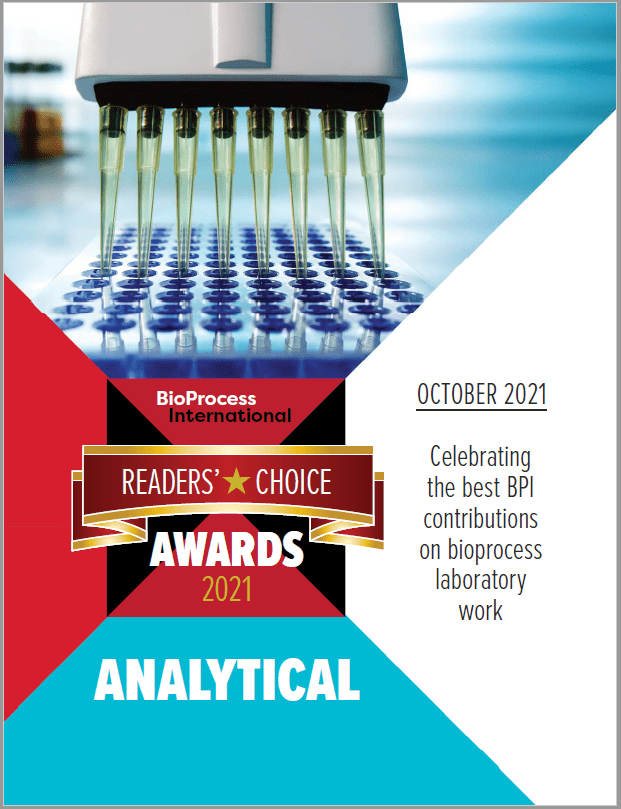 2021 Readers’ Choice Awards: Analytical
2021 Readers’ Choice Awards: Analytical
Biologics of all kinds present development challenges in measuring product quality and consistency. This is just one area in which analytical laboratories provide a vital foundation to biopharmaceutical process and product development. Quality specialists help process engineers troubleshoot when things go wrong; formulators find ways to prioritize patients’ needs in drug-product design; validation and comparability specialists help ensure process and product consistency; and innovators find ways to apply new knowledge to process control.
This year’s nominees in the Readers’ Choice analytical category represent advances from across the bioprocess spectrum. Chilmonczyk and Fedorov show how a dynamic sampling platform addresses the clear industry need for an integrated PAT system for bioreactor monitoring. Mire-Sluis et al. report about presentations and discussions from the January 2019 CASSS CMC Strategy Forum, the agenda for which featured the definition, identification, control, and management of patient-focused attributes throughout the life cycle of biological products. Pathange, Shimoni, and Srinivasan chronicle their team’s development of corrective and preventive actions when out-of-specification results arose during a perfusion culture process. And Shahrokh et al. address technical, practical, and regulatory facets of drug-product process validation and comparability.
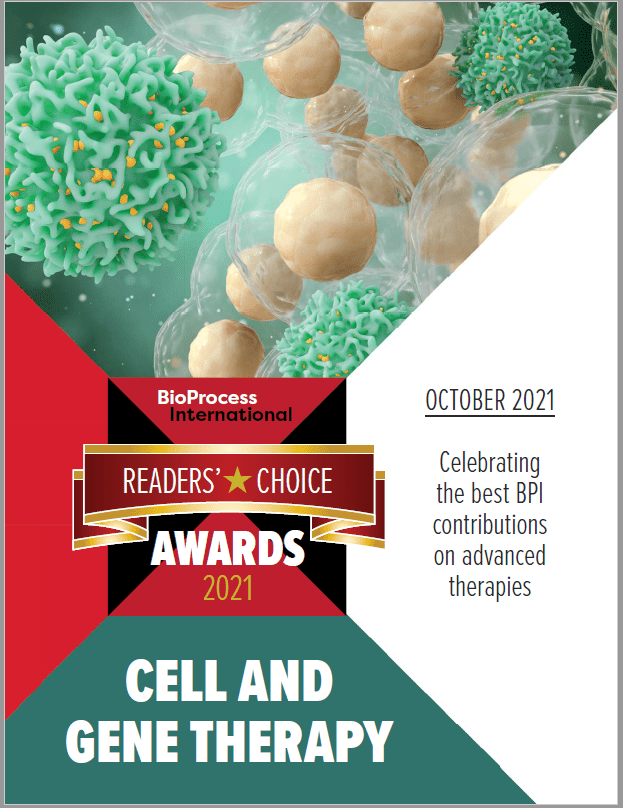 2021 Readers’ Choice Awards: Cell and Gene Therapies
2021 Readers’ Choice Awards: Cell and Gene Therapies
Over the past year, BPI readers continued to be highly interested in the development, manufacture, and characterization of cell and gene therapies (CGTs). As evidenced by this year’s nominees, scalability and quality concerns remain at the front of scientists’ minds. Featured in this eBook are BPI’s top four articles about cell and gene therapy production from September 2020 through June 2021.
Apte et al. explore factors that continue to complicate CGT manufacturing, then highlight regulatory pathways that could help therapy developers to fast-track their products to the market. Bream and Salzmann present findings from a survey of 150 biopharmaceutical industry leaders concerning CGT facility requirements and preparations for increasing production capabilities. Goldberg overviews analytical performance characteristics that must be considered during development and validation of assays for cell therapy products. And Jin describes how Droplet Digital polymerase chain reaction (ddPCR) assays can be used to track and quantify chimeric antigen receptor (CAR) gene sequences in transduced T cells.
 2021 Readers’ Choice Awards: Manufacturing
2021 Readers’ Choice Awards: Manufacturing
Everyone involved in biopharmaceutical manufacturing must keep current with regulatory guidance and technology trends. Finalists in this year’s Readers’ Choice Awards manufacturing category look both forward (to the burgeoning potential of bioprocessing 4.0) and back (to the aging facilities that don’t have to be left behind). In the process, the nominees define what is in many ways a transitional period for the industry. Quality by design (QbD) and risk-management principles permeate all these discussions, as should be no surprise.
Brower et al. provide heuristic tools for assessing a biologic’s manufacturability and identifying potential for process redevelopment activities within a resource-constrained environment. Chattaway’s article makes plain the many factors that can complicate technology transfer from a drug sponsor to a manufacturing partner. Kis describes how emerging software packages for process modeling could help accelerate the development of vaccines in response to global health crises. And Sandle explores 10 risk factors that deserve consideration when drug manufacturers plan to retrofit legacy facilities.
 2021 Readers’ Choice Awards: Downstream Production
2021 Readers’ Choice Awards: Downstream Production
Regardless of molecule, the goal of biopharmaceutical downstream processing is to reduce process- and product-related impurities while maintaining the highest possible process yield. However, emerging modalities such as those based on gene-edited human cells, transgenes carried by viral vectors, and proteins transferred by exosomes all are pointing out limitations in current downstream strategies, which by and large have been developed around purification of monoclonal antibodies (MAbs).
This year’s nominees in the BPI Readers’ Choice downstream category highlight technologies and processing strategies that biopharmaceutical developers and manufacturing organizations are developing to address the separation and purification demands raised by innovative therapies. Hundley and Königsson chronicle their team’s development of a fully single-use disc-stack centrifuge system that is designed for high-density cell cultures. Kamstrup and other writers with the BioPhorum industry consortium explore how a simple mathematical tool combined with failure mode and effects analysis can help biomanufacturers to predict quantitatively a viral-inactivation process’s risk for carryover contamination from pre- to postviral steps. Law et al. showcase a proprietary ligand-based exosome affinity purification (LEAP) platform that could enhance the scalability, reproducibility, and cost-effectiveness of extracellular vesicle purification. And Winkler et al. describe their application of noninfectious viral surrogates to assess the viral-clearance potential of a downstream process for a product based on adenoassociated virus (AAV).
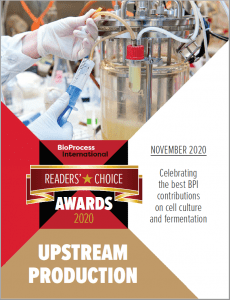 2021 Readers’ Choice Awards: Upstream Production
2021 Readers’ Choice Awards: Upstream Production
Bioprocessing begins with upstream production, most often with culturing of animal or microbial cells in a range of vessel types (such as bags or stirred tanks) using different controlled feeding, aerating, and process strategies. The nominated articles in this category present strategies for and case studies about optimizing upstream processes to support and improve characterization and development for current and next-generation protein therapeutics.
This year’s nominees all provide detailed roadmaps for improving upstream-process control, execution, and optimization. Ding et al. explain how control of dissolved oxygen influences the secretion and production of recombinant antibody fragments expressed during fermentation of Escherichia coli systems. Melinek et al. present a roadmap for development and implementation of systems for cell-free protein synthesis, as envisioned by a collaboration among University College London’s Department of Biochemical Engineering, the UK Future Targeted Healthcare Manufacturing Hub, and industry partners. Piestun’s article explores CRISPR–Cas9 technology’s implications for cell-line development activities. And Shimoni and Moehrle describe how compounded media-powder formulations could significantly reduce the cost and complexity of media preparation activities.
 Rare Diseases: Biopharmaceutical Challenges Presented By Relatively Small Patient Populations
Rare Diseases: Biopharmaceutical Challenges Presented By Relatively Small Patient Populations
By definition, an orphan disease affects a small percentage of the population. However, with some 7,000 such conditions identified so far, they collectively have a significant impact on global health. An estimated 350 million people are affected worldwide by a rare disease — altogether more than the population of the world’s third largest country (the United States). Some well-known biopharmaceutical companies are devoted to developing treatments for rare diseases. However, the vast majority of such diseases have no treatments approved by the US Food and Drug Administration (FDA) and/or other global regulatory bodies. For instance, during the first 25 years of the Orphan Drug Act (passed in 1983), only 326 such drugs were approved for the US market. To date, roughly 350 of the 7,000 known orphan diseases have approved therapeutic options.
This eBook explores financial, operational, logistical, and manufacturing-related obstacles to the production of treatments for rare diseases. First, BPI Senior Technical Editor Cheryl Scott shares insights from a recent conversation with Jim Faulkner (now a consultant, formerly head of vice president of rare disease manufacturing and supply at GlaxoSmithKline) about the practicalities of orphan drug development. Then Scott presents her virtual roundtable discussion with Martine Zimmermann (senior vice president and global head of regulatory affairs at Alexion Pharmaceuticals), Tania Pereira Chilima (chief technology officer at Univercells Technologies), and Monica Weldon (founder, president, and chief executive officer of Bridge the Gap — SYNGAP Education and Research Foundation) about the risks and rewards of developing rare disease treatments. Finally, Scott Gray (cofounder and chief executive officer of Clincierge) describes how patient-support service providers can improve access to clinical trials with rare-disease indications for patients with significant logistical and economic barriers. Read the eBook now to learn more about the needs of patients and drug developers alike in the development of treatments for rare diseases.
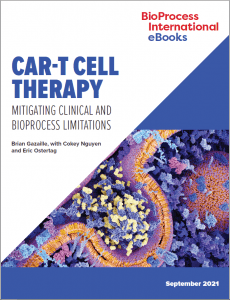 CAR-T Cell Therapy:
CAR-T Cell Therapy:
Mitigating Clinical and Bioprocess Limitations
Developers of chimeric antigen receptor (CAR) T-cell therapies are working in a state of tempered optimism. As of September 2021, the US Food and Drug Administration has approved only five such products, two coming this year. Now that those approved products have demonstrated the viability of CAR-based immunotherapies, drug developers are trying to address significant limitations that have come to light with increases in available clinical data and bioprocess knowledge. One shortcoming concerns therapeutic efficacy. Blood cancer patients who have been treated with CAR-T products often respond well initially but find their cancers relapsing over time, and these cell therapies have shown only modest success against solid tumors. A second limitation relates to autologous processing, which remains by far the most common approach to CAR-T production — and the only strategy used for the five currently approved products. Despite such concerns, cell therapy developers remain undeterred and many new candidate therapies in clinical trials feature compelling new CAR designs and CAR-T production processes. In this eBook, BPI’s associate editor shares interviews with two executives representing clinical-stage cell therapy companies. The conversations herein describe emerging strategies for increasing CAR-T effectiveness against solid tumors, transitioning from autologous to allogeneic processing, and perhaps accomplishing both goals simultaneously. Download the eBook now to learn strategies for sourcing sufficiently healthy T cells, improving therapy efficacy and longevity, and anticipating large-scale manufacturing requirements.
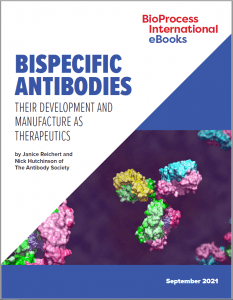 Bispecific Antibodies:
Bispecific Antibodies:
Their Development and Manufacture As Therapeutics
Generating antibodies with two or more specificities is one of the most innovative fields in therapeutic antibody development, with tremendous potential for use in creating new treatments for patients with unmet medical needs. In particular, bispecific antibody development is stimulating innovations in bioprocessing techniques from expression through upstream processing and candidate purification. Wherever possible, process-development scientists and engineers are borrowing techniques that were honed for mature monoclonal antibody (MAb) platforms, then applying those to bispecific antibody manufacturing. Nevertheless, the unique qualities of bispecifics make development of biomanufacturing strategies for them a still-emerging art form. Much remains to be done toward creating high-producing and high-yielding processes for this class of products, and challenges are likely to increase as bispecifics become even more sophisticated. In this eBook, Janice Reichert and Nick Hutchinson of The Antibody Society review the state of bispecific antibody development and describe the manufacturing-related obstacles that drug companies are facing as their candidates progress through clinical trials. Download the eBook now to learn how advances in protein-expression systems, gene-engineering platforms, and purification processes could help to improve bispecific manufacturability.
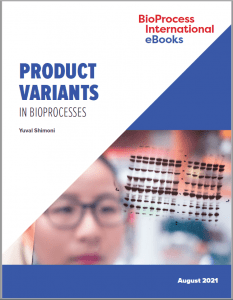 Product Variants in Bioprocesses
Product Variants in Bioprocesses
Product variants are contaminants because they bear properties that are different from those of desired biological products with respect to activity, efficacy, and safety. Thus, such variants can compromise product quality and consistency. In this eBook, Yuval Shimoni explores different types of variants — including primary-sequence variants, undesirable posttranslational modifications, aggregates, and degraded proteins — and explains how their presence can diminish the performance and quality of drug substances and products. He also discusses how product variants form at different process development stages and in response to manufacturing changes, highlighting some of the chromatographic, spectrometric, and electrophoretic methods that analysts use to detect and characterize them. Underscoring the importance of variant detection for both existing and emergent biopharmaceuticals, Shimoni anticipates how such screening technologies and practices might be applied to the characterization of mRNA-based products, including some of the SARS-CoV-2 vaccines that regulatory agencies have authorized for emergency use.
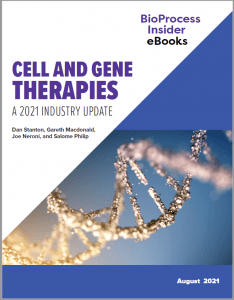 Cell and Gene Therapies: A 2021 Industry Update
Cell and Gene Therapies: A 2021 Industry Update
The US Food and Drug Administration (FDA) reports that as of June 2021, 22 advanced therapy products have received regulatory approval in the United States. The first such product gained regulatory approval in 2010. Since then, hundreds of cell and gene therapies have advanced to clinical evaluation, but few products have reached commercial stages — and those that have done so have been hindered by manufacturing problems. In this eBook, writers from the BioProcess Insider and Project Farma analyze trends in cell and gene therapy investment, including a relative slow-down in investor activity compared with the surge of capital that the industry experienced during the initial phases of the COVID-19 pandemic in 2020. Then, the writers explore business- and manufacturing-related challenges that continue to hold therapy developers back from commercial success and explore potential solutions to those challenges. Among the most promising developments are holistic planning approaches to cell and gene therapy development and implementation of “flexible” manufacturing technologies and facility designs. Perhaps by incorporating such materials and strategies, the cell and gene therapy industry can usher greater numbers of candidate therapies into early manufacturing and commercial stages.
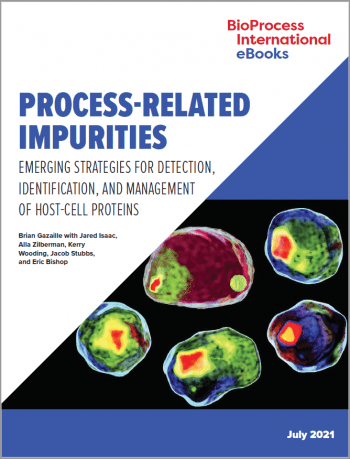 Process-Related Impurities:
Process-Related Impurities:
Emerging Strategies for Detection, Identification,
and Management of Host-Cell Proteins
Host-cell proteins (HCPs) represent a major class of process-related impurities (PRIs) that are generated during biopharmaceutical manufacture. Although the vast majority of such proteins are removed from a drug substance during downstream purification, residual HCPs can remain in a finished drug product. Even in minimal concentrations, copurifying HCPs can pose safety risks and compromise protein-product yield, efficacy, and stability. Thus, regulatory agencies consider the presence of HCPs to be a critical quality attribute (CQA). Sufficient clearance of these impurities helps to establish a bioprocess’s robustness. But HCP detection is easier said than done.
This eBook explores strategies for HCP detection, identification, and management that were presented at the ninth annual BioPharmaceutical Emerging Best Practices Association (BEBPA) Host Cell Protein Conference. This year’s program featured considerations for transitioning between commercial HCP kits and platform assays, advances in high-throughput assay technologies, the increasing importance of liquid chromatography–mass spectrometry in HCP analytics, and novel strategies for detecting and addressing HCP-related excipient degradation. Then, authors from eBook sponsor Cygnus Technologies describe how the company’s antibody affinity extraction (AAE) chromatography process coupled with mass spectrometry can enhance HCP identification and quantification. The authors demonstrate that AAE steps can deplete drug substance within a sample and enrich its HCP populations, enhancing mass spectrometric analyses.
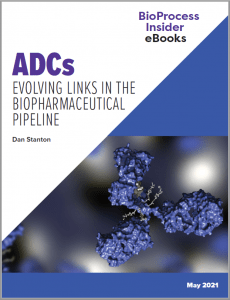 ADCs: Evolving Links in the Biopharmaceutical Pipeline
ADCs: Evolving Links in the Biopharmaceutical Pipeline
Antibody–drug conjugate (ADC) developers both old and new are talking about the next generation of drug candidates coming through their pipelines. In April 2021, Zynlonta (loncastuximab tesirine, from ADC Therapeutics) became the eleventh such product to receive approval from the US Food and Drug Administration (FDA). But with dozens of ADC candidates currently in clinical trials, those 11 products represent the tip of the ADC iceberg. In this eBook, Dan Stanton (founding editor of BioProcess Insider) explores ADC production history, investment records, and regulatory approval patterns. By tracing those elements, Stanton highlights different generations of ADC approaches and then explains how the modality is likely to evolve as interest and investment continue to rise. Read the eBook to learn more about emerging trends in ADC production, including improved linker technologies, novel payloads, and significant decreases in therapy toxicity.
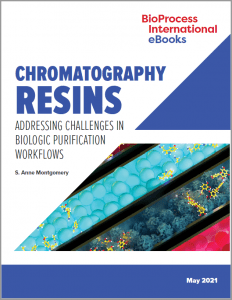 Chromatography Resins: Addressing Challenges in Biologic Purification Workflows
Chromatography Resins: Addressing Challenges in Biologic Purification Workflows
Although chromatography remains the backbone of downstream workflows, selecting appropriate technologies to optimize processes can be challenging. Numerous resin options are available, and the fact that most biologics are large, complex, and inherently unstable further complicates development of a robust workflow. Because chromatography processes can alter a biologic in ways that could impair its intended therapeutic function, investment in process development is critical. Techniques such as design of experiments (DoE) can be used to identify the best approach during process development. Areas of focus typically include reducing the number of chromatography steps, improving step transitions for better process economics, selecting resins that are salt and pH tolerant to improve stability of biologic products, and ensuring scalability of resins. Several factors affect chromatography resin selection, including required physicochemical characteristics and desired purity for final application.
As this eBook explains, each resin has unique properties, and purification strategies often are divided into steps such as capture, intermediate, and polish. Resins used in each step must be selected based on whether they can overcome specific challenges presented by different biologics and deliver desired process economics, timelines, and purity, among other factors. Read on to learn about stage- and modality-specific criteria for chromatography resin selection, including recommendations for purification of plasmid DNA, viruses and virus-like particles, and emerging modalities.
 Bioreactor Sensors: Inside the Dynamics of Cell Culture
Bioreactor Sensors: Inside the Dynamics of Cell Culture
Cell culture monitoring can fall into something like a “black box” conundrum. Efforts to measure key parameters such as pH, glucose, and even cell density require sampling and removal of the contents from a bioreactor. But that procedure can expose both a process and an operator to contamination risks. Emerging bioreactor sensors are designed to address some of those challenges, but the rapid adoption of single-use technologies and the rise of perfusion cell culture have presented obstacles to their implementation. In this eBook, science writer Jim Kling explores how next-generation sensors and extensions of existing product lines could help upstream scientists to learn more about their cell cultures without compromising product quality attributes. Read on to learn about improvements to sensors embedded in single-use bioreactor systems, novel designs for inline electrochemical sensing, and challenges that remain for developing sensors for continuous bioproduction. Kling’s discussion also considers how wireless and cloud-connected sensor technologies as well as statistical-model–based “soft sensors” could facilitate culture monitoring.
 mRNA: Revisiting a Technology
mRNA: Revisiting a Technology
That Has Rocketed into Success
At the end of 2018, BPI published its first eBook about mRNA drug products — and quite a lot has happened since then! Our initial report highlighted companies working on mRNA therapeutics for cystic fibrosis, heart disease, and cancer, as well as vaccines. The latter approach took off in 2020 with the advent of SARS-CoV-2 and the COVID-19 pandemic, and in a stunningly short time, the biopharmaceutical industry has learned much about manufacture, formulation, product design, and distribution of mRNA drug products. Reflecting on that 2018 publication, this eBook takes stock of recent advances in mRNA production and identifies continuing areas of need.
First, BPI’s editor in chief and former editorial assistant explore mRNA’s potential applications, not only for vaccines, but also for cancer treatments and beyond. Next, BPI’s senior technical editor speaks with an industry consultant about technical factors that have propelled mRNA into the limelight, including improvements in lipid nanoparticle (LNP) systems. Their conversation also sheds light on unprecedented demand for mRNA-related reagents and raw materials as well as continuing challenges with developing mRNA drug product formulations that do not require ultracold storage. Finally, a leader from DPS Group Global calls attention to challenges that arise when designing facilities for manufacture of mRNA drug products, which straddle the requirements for conventional biopharmaceuticals and small-molecule drugs.
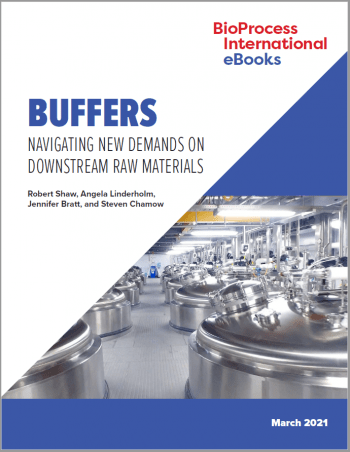 Buffers: Navigating New Demands on
Buffers: Navigating New Demands on
Downstream Raw Materials
Bioreactor titers for monoclonal antibody (MAb) processes have increased significantly since the dawn of the biopharmaceutical industry, yet such gains have instigated bottlenecks for critical high-volume raw materials used in downstream processing, such as buffer solutions. As downstream purification is required for most, if not all, biopharmaceutical products, buffers and their preparation are topics that concern nearly every drug company. But those topics rarely receive direct attention.
This BPI eBook explores what factors prompted the current buffer bottleneck and what options drug sponsors might consider to negotiate such hurdles to operational efficiency. First, a BPI editorial advisor and executive director of the Standards Coordinating Body for Gene, Cell, and Regenerative Medicines and Cell-Based Drug Discovery (SCB) contextualizes the buffer bottleneck, then lays out scientific, operational, logistical factors that end users should consider when deciding whether to in- or outsource buffer production. Following that discussion, biopharmaceutical-industry consultants from Alira Health share their interviews of a buffer-chemical supplier and end user. The interviews explore strategies for mitigating shortages of chemicals used in raw materials. Read this eBook to learn more about the complex precision, validation, and supply-chain considerations that undergird what merely seem to be simple bioprocess solutions.
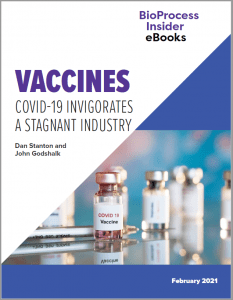 BioProcess Insider eBook Series: Vaccines — COVID-19 Invigorates a Stagnant Industry
BioProcess Insider eBook Series: Vaccines — COVID-19 Invigorates a Stagnant Industry
The SARS-CoV-2 novel coronavirus has galvanized what was a stagnant and oligopoly-run vaccine industry. In this inaugural BioProcess Insider eBook, the first of four to be published in 2021, founding editor Dan Stanton explores economic and technical conditions that until now have hampered innovation in vaccine development and discouraged market entry for emerging biotechnology companies. Leveraging commentary from vaccine industry experts and analyzing the range of emerging vaccine modalities, Stanton surveys how industry responses to the COVID-19 pandemic are fostering research, development, and manufacturing technologies that hold promise not only for mitigating the current pandemic, but also for addressing other public health crises. Bioprocess consultant and former US Food and Drug Administration (FDA) inspector John Godshalk explains what difficulties lie ahead for authorized vaccine products with exacting cold-chain specifications.
 Formulation, Fill–Finish: Biopharmaceutical Drug-Product Trends and Technologies
Formulation, Fill–Finish: Biopharmaceutical Drug-Product Trends and Technologies
As with many other aspects of biopharmaceutical development, evolving technologies are transforming drug-product development and manufacturing. In a November 2020 report on the Informa Connect “Drug Delivery Partnerships” meeting, BPI senior technical editor Cheryl Scott reviewed how new delivery-device technologies are bringing together companies with disparate expertise to serve patients with chronic conditions better than ever before. The ever-increasing capabilities of electronics and information technology (IT) not only are enabling development of “smart” delivery devices, but also improving the potential (and business case) for automating drug-product formulation, testing, and manufacture. Meanwhile, new product modalities are challenging old delivery methods and pushing distribution systems to the limit — making companies consider alternatives anew. Even before all these developments, drug-product manufacturing often was considered to be a separate business from drug-substance production. And many, if not most, biopharmaceutical companies have counted on partnerships and outsourcing contracts to turn their bulk drug substances into formulated and packaged drug products.
This eBook explores some ways that such trends are manifesting. First, Scott reviews how biologic drug-product manufacturing is changing to keep up with new and improved delivery methods and regulatory developments. Her analysis highlights some advancements in formulation analytics and considers where those changes might be taking the drug-product business. Next, BPI associate editor Brian Gazaille discusses a new freeze-drying method that could disrupt the cold-chain distribution paradigm in a post–COVID-19 world. His interview elucidates how inhalable formulations soon could be a viable option for emerging vaccines and biologics.
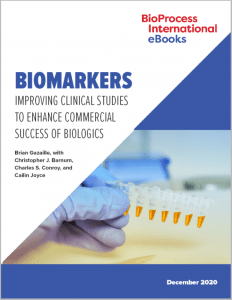 Biomarkers: Improving Clinical Studies to Enhance Commercial Success for Biologics
Biomarkers: Improving Clinical Studies to Enhance Commercial Success for Biologics
The biopharmaceutical industry continues to invest heavily in technologies for identification of predictive biomarkers. Drug developers want not only to find quantitative evidence that their therapies will work as designed, but also to anticipate which patient populations will respond positively to those regimens. Doing that could streamline clinical trials, accelerate approvals, and ultimately improve patient outcomes. Advances in next-generation sequencing and increases in computational capability now are facilitating biomarker inquiries, especially in the realm of immunooncology. However, predictive biomarkers remain elusive for many cancers and autoimmune disorders.
In this eBook, BPI’s associate editor shares three interviews with industry experts about what factors still impede identification of predictive biomarkers and what methods and materials are needed to negotiate such hurdles. These conversations shed light on the need to investigate biomarker “signatures” rather than single genes or proteins; the role that artificial intelligence (AI) will play in drug discovery and development, especially as the biopharmaceutical industry gathers increasingly large stores of genomic and proteomic data; the need for fields outside of oncology, including neurology, to adopt biomarkers-driven approaches to drug development and clinical-trial design; and the advent of radioisotope-based theragnostic products that are designed to treat and monitor the progression of cancer simultaneously.
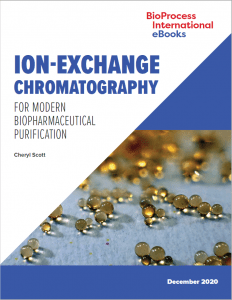 Ion-Exchange Chromatography for Modern Biopharmaceutical Purification
Ion-Exchange Chromatography for Modern Biopharmaceutical Purification
Ion-exchange (IEX) chromatography separates biomolecules on the basis of charge. For several reasons, it is the most widely used separation tool for purification of biopharmaceutical products. IEX is a well-characterized purification method with high binding capacity and flexible selectivity. It also works with mild operating conditions that help to preserve the biological activity of a biopharmaceutical drug substance. That versatility enables several options for capture, intermediate, and polishing steps in downstream processing, including nonaffinity capture of recombinant proteins and antibodies, purification of large biomolecules, and removal of a wide range of impurities.
In this eBook, BPI’s senior technical editor explores practical considerations for IEX chromatography workflows. The author overviews critical criteria for resin selection (e.g., particle size, flow rate, and dynamic binding capacity) and then describes specific applications in which IEX can be an ideal bioseparation tool, including nonaffinity capture of proteins and antibodies, high-resolution separation of charge variants developed during antibody production, purification of viruses and other large molecules, and removal of process-related impurities.
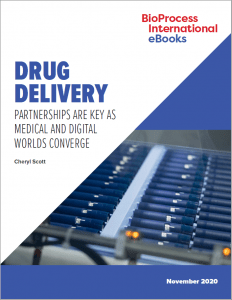 Drug Delivery: Partnerships Are Key As Medical and Digital Worlds Converge
Drug Delivery: Partnerships Are Key As Medical and Digital Worlds Converge
Drug delivery is advancing into a digital future. Information technology is changing aspects of every operation in the biopharmaceutical industry. Meanwhile, machine learning and cloud computing are not only finding their way into drug development, manufacturing, and distribution, but also into drug-product delivery devices themselves. As a result, many biopharmaceutical companies are seeking medical device expertise through strategic alliances and contract services. New delivery devices can help big companies extend patent protection on established marketed products, for example, and provide small startups with a way to stand out in a crowded market environment. Discussions at Informa Connect’s “Drug Delivery Partnerships” meeting this year elucidated many details of the digital-health trend along with other advancements in drug delivery.
In this eBook, BPI’s senior technical editor highlights the meeting’s major trends, including emerging technologies for oral administration and delivery across the blood–brain barrier, growing demand for device connectivity to apps and smart devices, and the biopharmaceutical industry’s increasing focus on patient-centered solutions. The meeting also offered advice to established pharmaceutical companies and startups alike about navigating the kinds of drug delivery partnerships that are becoming the norm.
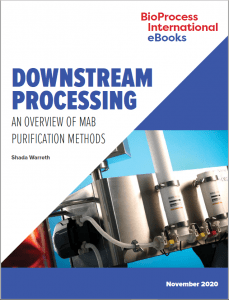 Downstream Processing: An Overview of MAb Purification Methods
Downstream Processing: An Overview of MAb Purification Methods
The downstream harvest, clarification, and purification operations of biologics are essential steps to ensure drug product safety. However, these process steps can be problematic for complex biologics. Compared with processes for traditional small-molecule pharmaceuticals, downstream methods for monoclonal antibodies (MAbs) have higher risks of contamination. Thus, different centrifugation, filtration, chromatography technology and viral clearance/inactivation strategies must be applied to remove dead cells, host-cell proteins, viruses, and other contaminants. Several factors must be considered to determine which methods and technologies are best for each downstream process. In this eBook, Shada Warreth, an author from Ireland’s National Institute for Bioprocessing Research and Training (NIBRT), reviews essential MAb purification methods and explores key considerations for harvest/clarification, ultrafiltration/diafiltration (UF/DF), and viral clearance steps. The primary challenge, Warreth shows, is to select downstream equipment and methods that work together, offer the best-fit option, and keep up with rising product titers and increasing complexities of cell-culture process fluids to be clarified, purified, and filled into final containers.
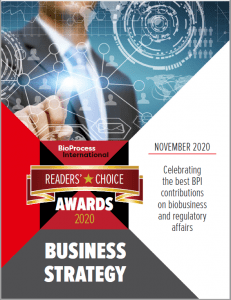 2020 BPI Readers’ Choice Awards: Business Strategy
2020 BPI Readers’ Choice Awards: Business Strategy
Managing biopharmaceutical business decisions requires understanding complex interrelationships among multiple trends. Among those are continuing supplier consolidations, collaborations between industry and academia and between suppliers and end users, and opportunities arising from increased global regulatory harmonization. Factoring in parallel advances in technologies, therapeutic modalities, analytics, and automation, business developers can take advantage of expanded tools and geographic options for securing contract manufacturing capacity around the world. As companies step up to the tasks of manufacturing and distributing vaccines and therapies for COVID-19, the industry may never before have been this well-prepared to face the challenges ahead of it.
The four nominated articles in our business strategy category this past year confirm those and related trends. The top-ranked article provides a “deep dive” into analyzing capacity trends — knowledge that will be critical toward finding manufacturing space for and distribution of COVID‑19 treatments. The second-place article traces the benefits of supplier consolidation, urging creation of a worldwide network of facilities to speed production of clinical materials, conduct research, and scale-up trials. And regulatory reforms drive the content of our third- and fourth-place articles that describe increasing collaboration between academic researchers and commercial end users in Canada and greater opportunities for outsourcing manufacturing to Chinese companies, respectively.
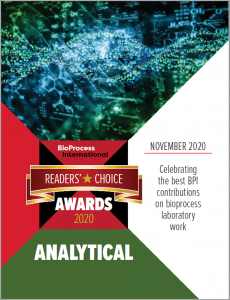 2020 BPI Readers’ Choice Awards: Analytical
2020 BPI Readers’ Choice Awards: Analytical
Knowledge is power in biopharmaceutical development and manufacturing. Thus, analytical methods underlie every activity from drug discovery and developability testing through production and processing to final-product formulation and lot release. Collection, management, and use of data also are key to successful market authorization of biologics across regulatory jurisdictions.
The four nominated articles in this Readers’ Choice Awards category address those concerns and more for different product modalities (cell therapies, recombinant proteins, and diagnostics) and across different process stages. Means for assessing the status of cells in culture figure heavily in the winning articles. And COVID-19 rears its ugly head, as was perhaps unavoidable this year.
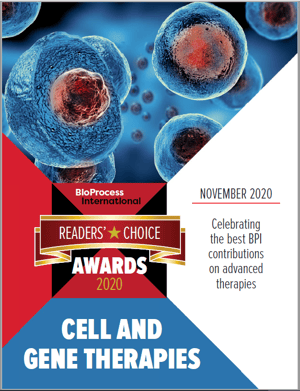 2020 BPI Readers’ Choice Awards: Cell and Gene Therapy
2020 BPI Readers’ Choice Awards: Cell and Gene Therapy
Cell and gene therapies are reshaping all aspects of the bioprocess industry to such an extent that they have earned their own, product-focused category in the 2020 BPI Readers’ Choice Awards. The authors of the nominated articles address key manufacturing and quality areas for these advanced therapies and how to address common process challenges.
Nominees for the cell and gene therapy category include a Latham Biopharm Group report about increasing demand for viral vector production, a former FDA reviewer’s rationale for why cell and gene therapy products do not need distinct GMP guidelines or CMC requirements, a multiorganization discussion of quality by design (QbD)’s applicability to cell and gene therapy manufacturing, and a company’s exploration of herpes-assisted vector expansion (HAVE) processes for production of adenoassociated virus (AAV) vectors.
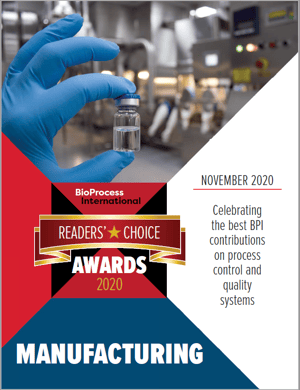 2020 BPI Readers’ Choice Awards: Manufacturing
2020 BPI Readers’ Choice Awards: Manufacturing
Closed systems and single-use technologies, continuous processing and process analysis are transforming biopharmaceutical manufacture. This year’s Readers’ Choice nominees and other top articles in manufacturing emphasize such advances as well as the growing importance of automation and data management, vaccines and single-use technologies, virus safety, and platform approaches for advanced therapy manufacture.
Nominees include a pre-COVID-19 analysis of trends in the vaccine industry, an exploration of the BioPhorum Operations Group’s work toward developing a standardized software architecture for biomanufacturing systems, a careful examination of the biopharmaceutical industry’s needs for “big data” processing, and a sample response plan for viral contamination incidents in bioproduction facilities.
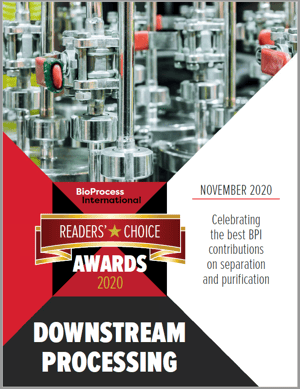 2020 BPI Readers’ Choice Awards: Downstream Processing
2020 BPI Readers’ Choice Awards: Downstream Processing
In recent years, biomanufacturers have needed to design downstream processing schemes to meet the specific needs of complex biologics such as cell and gene therapies. Current approaches to intensify production titers are putting added pressure on downstream operations to match capacity requirements. And the need for shortened pathways toward product approval from regulatory agencies has biomanufacturers wanting streamlined downstream process lines. Nominees for the downstream category of the 2020 BPI Readers’ Choice Awards exemplify this shift in downstream strategy for complex therapeutics.
Nominees include papers about ensuring effective and continuous downstream processing of harvests gathered from perfusion cell cultures, integrity testing for viruses filters used in vaccine product development, purification of adenoviruses using membrane adsorbers, and capture of bispecific antibodies using hydroxyapatite-based media as an alternative to protein A.
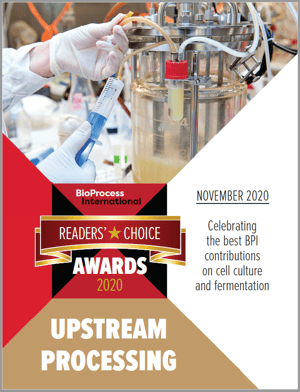 2020 BPI Readers’ Choice Awards: Upstream Processing
2020 BPI Readers’ Choice Awards: Upstream Processing
Perennial concerns about optimizing protein-expression systems, improving bioreactor designs, and increasing yields continue to dominate discussions about upstream production. However, the nominees for this year’s upstream Readers’ Choice Award suggest that the biopharmaceutical industry sits on the cusp of several important transitions. Two of those articles indicate a shift in the industry’s valuation of serum-supplemented cell culture media. A third paper describes the biopharmaceutical industry’s need for effective large-volume single-use systems for fermentation. The final nominee explores chemistry, manufacturing, and controls concerns for optimizing cell line selection.
 Mixed-Mode Chromatography for Purification of Biopharmaceuticals
Mixed-Mode Chromatography for Purification of Biopharmaceuticals
Mixed-mode chromatography offers several advantages in downstream processing of biotherapeutics. Mixed-mode chromatography resins use ligands that are capable of at least two modes of interaction with solutes such as hydrophobic, ion exchange, and metal affinity. The interactions between stationary and mobile phases that result from those combinations enhance chromatographic selectivity, facilitating separation efficiencies that are not possible using other chromatography media.
As this eBook illustrates, the multimodal approach can save developers time and money by enabling robust purification of biopharmaceuticals in a single chromatographic step. As a result, this technology offers the potential to purify proteins for which single-mode approaches are insufficient, even when used sequentially.
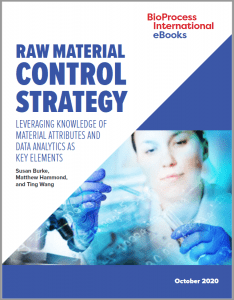 Raw Material Control Strategy: Leveraging Knowledge of Material Attributes and Data Analytics as Key Elements
Raw Material Control Strategy: Leveraging Knowledge of Material Attributes and Data Analytics as Key Elements
Ensuring pharmaceutical quality begins with in-depth understanding of process/platform capabilities, which is informed by knowledge gained through product and process development, subject-matter expertise, and lessons learned from experience. And all outside factors that can affect manufacturing outcomes must be taken into consideration. Extra vigilance is necessary for understanding potential sources of variation and maintaining robust control strategies to ensure process consistency — and ultimately product quality for patients. Biomanufacturing unit operations require multiple raw materials that must be documented as fit for their intended use. Coming from multifaceted supply chains with many starting materials and subsuppliers, bioprocess raw materials present a challenging source of variation. In this eBook, authors from Amgen describe the elements of a strategy for raw material controls using data analytics to enhance understanding for predict-and-plan capabilities.
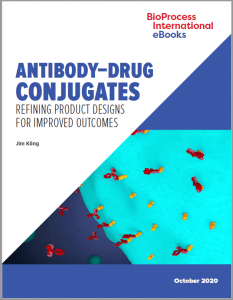 Antibody–Drug Conjugates: Refining Product Designs for Improved Outcomes
Antibody–Drug Conjugates: Refining Product Designs for Improved Outcomes
Antibody–drug conjugates (ADCs) seek to partner the target specificity of antibodies with the cell-killing punch of chemotherapy drugs. Researchers identify antibodies that bind to proteins found predominantly or exclusively on the surfaces of cancer cells. The cells can absorb the ADC into their interiors, where the chemical environment or enzymes detach the drug from the antibody, freeing it to wreak havoc. Although nine ADCs have received US Food and Drug Administration (FDA) or European Medicines Agency (EMA) approval (and many more are in development), they have yet to become a universal success. Quite a few therapeutic programs have been abandoned because of dose-limiting toxicities — when side effects become too severe at doses high enough to control a tumor. To address such problems, researchers and companies are tweaking the drug payloads and chemical linkers that form the bridges between the therapeutic drugs and antibodies. Additionally, some researchers are beginning to use milder drugs in greater numbers to improve dosing flexibility. In this eBook, Jim Kling focuses on how such new approaches to ADC design may be altering the field’s trajectory.
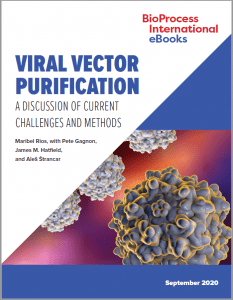 Viral Vector Purification: A Discussion of Current Challenges and Methods
Viral Vector Purification: A Discussion of Current Challenges and Methods
Adenoassociated viral (AAV) vectors have become synonymous with gene therapy delivery. However, because they are produced in such small quantities and because their upstream processes carry comparatively large amounts of host-cell DNA and other impurities, AAV purification can be challenging. Several researchers have applied different chromatographic strategies, but no universal method has been adopted in the biopharmaceutical industry.
This eBook features a discussion among several industry experts that explores challenges specific to AAV purification, shedding light on whether current strategies and separation technologies are up to the task. The conversation traverses issues relating to material handling at the upstream–downstream interface, removal of host-cell DNA, chromatographic separation of empty and full capsids, and a lack of fast and robust in-process analytics for downstream processes. Participants also explore whether the rise of AAV-based treatments will require downstream scientists to shift away from the antibody-centered conceptions of chromatography that have grown alongside the biotherapeutics industry.
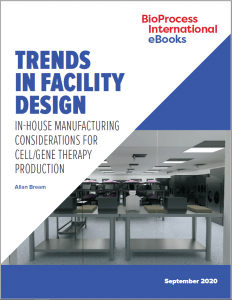 Trends in Facility Design: In-House Manufacturing Considerations for Cell and Gene Therapy Production
Trends in Facility Design: In-House Manufacturing Considerations for Cell and Gene Therapy Production
Manufacturing and facility challenges facing cell and gene therapy companies are similar to but more complex than those encountered by companies that produce traditional biopharmaceuticals such as vaccines, monoclonal antibodies, and other therapeutic proteins. A single product can have multiple components, manufacturing of which may or may not be outsourced. Project timelines are short, production technologies are new and evolving, and clinical demands change rapidly. Increasing competition for contract manufacturing services requires reserving capacity far in advance, which in most cases will not offer the agility needed by developers of advanced therapy medicinal products – many of which are vying to be the first to launch a product for the same indication.
The author of this eBook explains how new technologies enabling companies to reduce their operating footprints also enable manufacturers of cell and gene therapies to bring more of their critical processes in house, constructing production facilities that can be flexible and responsive to future demands. His own company’s goal is a multimodal facility that, by incorporating a universal suite design, can produce any combination of platform products: plasmids, viral vectors, or cell therapies. Each production space should be capable of operating in any mode, with proper decontamination between campaigns, and of switching from one platform to another. The ability to leverage and customize such state-of-the-art approaches to cell and gene therapy manufacturing should hasten entry of emerging advanced therapeutics into the marketplace.
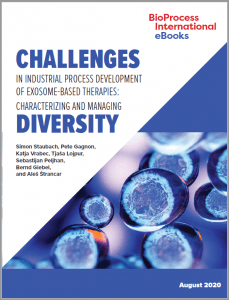 Challenges in Industrial Process Development of Exosome-Based Therapies: Characterizing and Managing Diversity
Challenges in Industrial Process Development of Exosome-Based Therapies: Characterizing and Managing Diversity
The traditional classification of extracellular vesicles (EVs) includes three types: exosomes, microvesicles, and apoptotic vesicles. Each type arises from a distinct origin and exhibits distinct characteristics. The problem is that their size ranges overlap and that the major surface proteins presented by exosomes also are present on the surfaces of microvesicles and apoptotic bodies. This makes it a challenge for process developers to identify the vesicle fraction that best serves a particular exosome therapy. Anion-exchange chromatography (AEC) can fractionate EVs into populations of different composition. This article highlights the complementarity of two analytical methods for characterizing distinctions among EV populations separated by AEC: imaging flow cytometry (IFCM) and size-exclusion chromatography.
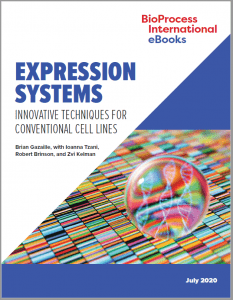 Expression Systems: Innovative Techniques for Conventional Cell Lines
Expression Systems: Innovative Techniques for Conventional Cell Lines
Although Chinese hamster ovary (CHO) and Escherichia coli cells have become the biopharmaceutical industry’s preferred platforms for producing recombinant proteins, perennial challenges have limited the capabilities of those expression systems. New CHO lines and improved upstream methods steadily are increasing expression titers, yet researchers continue to decry CHO’s relatively low growth rate. E. coli exhibits strong growth kinetics but cannot perform posttranslational modifications necessary for complex therapeutic proteins. Researchers need advanced technologies and analytical methods to overcome such limitations.
This eBook explores techniques that are assisting with scrupulous studies of CHO and E. coli. First, an interview with Ioanna Tzani of Ireland’s National Institute for Bioprocess Research and Training (NIBRT) describes next-generation sequencing (NGS) techniques and their implications for CHO-based cell culture. Tzani traverses current knowledge gaps regarding CHO genomics as well as technical requirements and template-preparation methods for successful NGS experiments. Next, Robert G. Brinson and Zvi Kelman, both of the US National Institute for Standards and Technology (NIST) describe their on the first platform for stable-isotopic labeling of monoclonal antibodies (MAbs) expressed in E. coli cells. Their discussion reveals the continuing relevance of E. coli in biopharmaceutical research and development, efforts to overcome E. coli‘s inability to glycosylate proteins, and the importance of isotopic labeling in protein characterization.
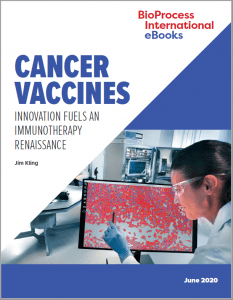 Cancer Vaccines: Innovation Fuels an Immunotherapy Renaissance
Cancer Vaccines: Innovation Fuels an Immunotherapy Renaissance
Despite early successes a decade ago, cancer vaccines designed to deliver peptides or proteins — or nucleic acids encoding those antigens — generally have fizzled out since then. As a result, cancer vaccine development and the field of immunotherapy lost some traction overall. But as freelance contributor Jim Kling describes in this eBook, new innovations in product design, testing, and manufacturing are fueling a renaissance in cancer vaccine development. From checkpoint inhibitors to neoantigens, immune regulators, and beyond, companies are exploring many modalities and technological strategies to make them work. What combinations of vaccines, immunotherapy, chemotherapy, and so on will provide cancer patients with the best results? Researchers remain optimistic as the detailed biology of tumors and our human immune system continue to be revealed.
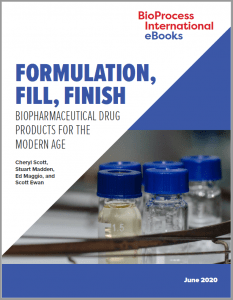 Formulation, Fill, Finish: Biopharmaceutical Drug Products for a Modern Age
Formulation, Fill, Finish: Biopharmaceutical Drug Products for a Modern Age
Biopharmaceutical drugs are increasing in sophistication, requiring technological advancements to solve related challenges. The contributors to this BPI eBook highlight drug-product formulation concerns and collaborative efforts toward solving the fill–finish conundrum.
First, the BioPhorum’s Scott Ewan describes a holistic approach to container–closure integrity and the organization’s work toward developing and expanding upon that approach. Ewan explores how advancing analytical technologies, risk management, and quality by design (QbD) are changing the strategies related to container–closure integrity, which remains a significant aspect of product safety and stability.
Then, authors from Neurelis highlight the difficulties faced by companies developing biopharmaceuticals for nasal delivery, featuring a promising solution for the key problem of absorption. They also point out difficulties with a familiar type of excipient: polysorbates, which have been common to drug-product formulation for many years. But recent studies show that they can degrade to cause aggregation and particle formation. In nasal delivery systems, polysorbates provide no assistance for solving the absorption problem, but alkylsaccharides can — without the aggregation side effects.
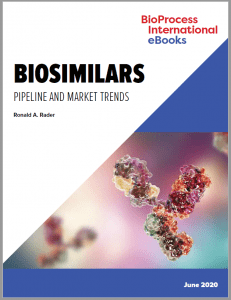 Biosimilars Pipeline and Market Trends
Biosimilars Pipeline and Market Trends
Most biopharmaceutical industry experts now consider biosimilars to be mainstream products, indicating that the field has progressed immensely over the past 10 years. Nevertheless, when comparing approvals and commercial offerings across the globe between 2013 and 2020, it becomes clear that some regions welcome these therapies more than others do. Western European biosimilars markets continue to be kind to these drugs’ production, distribution, and coverage; and companies headquartered in Asia and the Pacific Rim increasingly are getting involved in biosimilars and biogenerics production. But the United States, which boasts the world’s largest market for biopharmaceuticals, remains the largest potential and most underdeveloped biosimilars markets in the world.
In this eBook, a BioPlan Associates representative shares key results from his company’s 17th Annual Report and Survey of Biopharmaceutical Manufacturing Capacity and Production and explores why the States continue to lag behind other countries in distributing biosimilar products. Read on to learn how factors such as patent disputes and latent healthcare-system recalcitrance are holding back the development of biosimilars markets in the United States
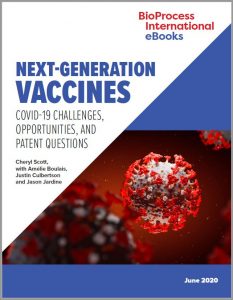 Next-Generation Vaccines: COVID-19 Challenges, Opportunities, and Patent Questions
Next-Generation Vaccines: COVID-19 Challenges, Opportunities, and Patent Questions
Resolving the COVID-19 pandemic depends on treatments, testing, and ultimately a widely disseminated vaccine against SARS-CoV-2. In recent decades, the biopharmaceutical industry has developed new approaches to vaccination using antigens, virus-like particles (VLPs), viral and bacterial vectors, and nucleic acids. Current events have placed those innovations at the front and center of public attention, offering many companies an opportunity to demonstrate their potential in an unprecedented way. Here, BPI’s senior technical editor describes the challenges that developers face in doing so, points to questions raised by hurried timelines and ethical concerns, and features some of the innovators leading the way. Patent attorneys from Knobbe Martens discuss the potential for governments to appropriate intellectual property related to products that emerge from all that development work. And a specialist from Sartorius Stedim Biotech highlights the importance of technology providers in achieving the goal of protecting everyone from COVID-19.
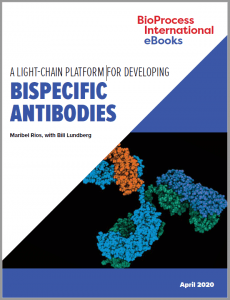 A Light-Chain Platform for Developing Bispecific Antibodies
A Light-Chain Platform for Developing Bispecific Antibodies
Biopharmaceutical researchers are focusing on novel platforms to quickly develop bispecific antibody (BsAb) therapies for treating complex diseases such as cancer. BsAb therapies offer several advantages because they are designed to bind two unique epitopes. In this report, Bill Lundberg, president and chief executive officer at Merus, describes his company’s efficient approach to developing BsAbs using “common light chain” technology and other proprietary strategies. Lundberg also addresses the company’s approach to typical BsAb development and manufacturing challenges.
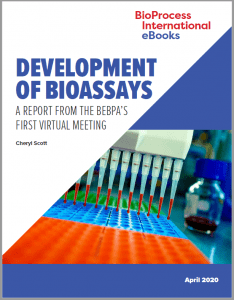 Development of Bioassays: A Report from the BEBPA’s First Virtual Meeting
Development of Bioassays: A Report from the BEBPA’s First Virtual Meeting
Bioassay development is one of the most challenging aspects of biotherapeutic development. These tests are vital to providing an accurate picture of potency, stability, and biological activity. But bioassay development can be complex and expensive — and often test results can vary. Cell-based bioassays especially lack robustness. In March 2020, the Biopharmaceutical Emerging Best Practices Association (BEBPA) presented its annual bioassay conference in virtual format. Here, BPI’s senior technical editor reports on the conference’s discussions. Read on to learn more about statistical strategies, assay variation and validation, potency and precision, and the relationships between bioassayists and statisticians in the modern bioanalytical laboratory.
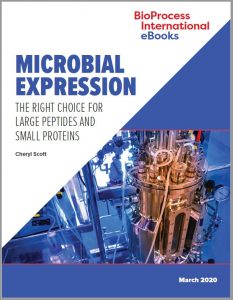 Microbial Expression: The Right Choice for Large Peptides and Small Proteins
Microbial Expression: The Right Choice for Large Peptides and Small Proteins
Although animal cell culture has dominated the biopharmaceutical industry for some years now, microbial expression remains important for producing proteins that don’t require posttranslational modifications — or only those that prokaryotic microbes can perform. It also offers an affordable option for antibody fragments and gene therapies. Microbes may be less fragile than animal cells, and they do require simpler media, but they present other challenges related to temperature management and oxygen transfer in culture. Wherever practical, bacterial expression is preferred for a number of reasons, from relatively easy genetic engineering to cost-effective process development, high expression levels, and a wide range of versatile plasmid vectors and host strains.
Read this BPI eBook to explore challenges in addressing future needs and opportunities for microbial expression systems in biopharmaceutical manufacturing. You also will learn about what contract manufacturers are cultivating expertise in to make peptides, proteins, and plasmid DNA using microbial expression systems.
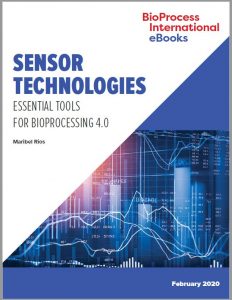 Sensor Technologies: Essential Tools for Bioprocessing 4.0
Sensor Technologies: Essential Tools for Bioprocessing 4.0
Sensors are essential devices that can be used for most, if not all, typical biopharmaceutical development and manufacturing processes to monitor fundamental process parameters such as flow, temperature, pH, and dissolved oxygen throughout all process stages. As the bioindustry progresses toward automation, digitalization, and other “Manufacturing 4.0” concepts, robust single-use and smart sensors for bioprocess monitoring will be needed. Read this BPI eBook to garner valuable perspectives on both of these types of sensors. Discussions herein focus on smart sensor capabilities, applications, and validation.
 Peptide Therapies: Small Biomolecules Address Big Health Problems
Peptide Therapies: Small Biomolecules Address Big Health Problems
This crash course in the development of peptide therapies brings together two articles: one on product research and the other on manufacturing and regulatory concerns. In “Fighting Alzheimer’s Disease from Within: A Breakthrough Peptide,” freelance journalist Marc Davis highlights current developments in Alzheimer’s disease treatment, focusing specifically on a peptide approach from Canadian company NervGen. In “Making Peptides Work,” BPI’s senior technical editor adds perspective on developing and manufacturing peptide therapies from the Informa Connect community, with commentary from experts in the industry. Look for remarks from George Perry (editor in chief of the Journal of Alzheimer’s Disease), Rodney Lax (PolyPeptide Group consultant), Michael Karney (CEM Corporation), Tom Barnes (Intellia Therapeutics), and Renata Varga (Teva Pharmaceutical). Market survey results highlight drug delivery and company collaboration, and conversations illuminate manufacturing technologies and quality by design.
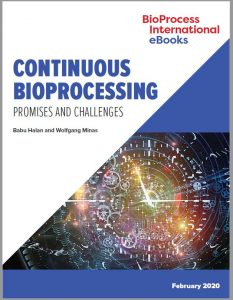 Continuous Bioprocessing: Promises and Challenges
Continuous Bioprocessing: Promises and Challenges
Biotechnological productions commonly are executed as batch processes, especially during downstream processing. Higher titers in fermentations, reductions in operating scale, and the quest for improving product quality all have led to an intensified effort for developing continuous processing. It is forecasted that within the next 10 years, about 50% of all drugs under development will be biopharmaceuticals, making it worthwhile to develop more efficient processes. In this BPI eBook, Babu Halan (project engineer) and Wolfgang Minas (global lead of the Competence Center for Biotechnology, both at Chemgineering Technology) highlight current trends, technologies, and challenges in continuous bioprocessing. Read on to learn more about the impact of single-use technologies on continuous bioprocessing and the downstream concerns that continue to hamper continuous operations.
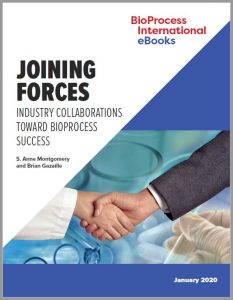 Joining Forces: Industry Collaborations Toward Bioprocess Success
Joining Forces: Industry Collaborations Toward Bioprocess Success
Companies in the biopharmaceutical industry increasingly are working together to solve the many challenges of product/process development and biomanufacturing. Suppliers seek end-user help in refining technologies; academics and small innovators attract the financing and business acumen of large companies; equal partners share in technological problem-solving; and sponsors engage the development expertise of contract research and manufacturing organizations. Other examples of biopharma industry collaborations abound, too. Citing critical examples from the September 2019 BioProcess International East Conference in Boston, MA, this eBook explores factors behind the upsurge in — and companies’ increased openness to — collaborations. Read on to explore representative examples of biopharma industry collaborations. You also will learn about the sense of “technological democracy” that is permeating the industry as well as emerging business models that seek to mitigate the risks of research and development (R&D) activities for end users and suppliers alike.
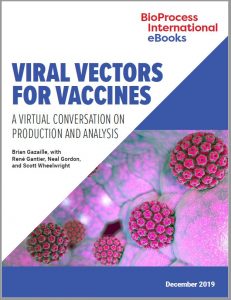 Viral Vectors for Vaccines: A Virtual Conversation on Production and Analysis
Viral Vectors for Vaccines: A Virtual Conversation on Production and Analysis
Although today’s vaccines are safer, more effective, and more accessible than they were even 20 years ago, the emergence of new, complex pathogens has exposed limitations in traditional vaccine strategies. Viral vector vaccines (VVVs) hold great promise for confronting those now-intractable pathogens. But drug companies and biomanufacturers still need to learn much about the modality to prepare VVV operations for commercial scales. This BPI eBook uses a “virtual roundtable” discussion among three industry experts — René Gantier (Pall Biotech, USA), Neal Gordon (BioProcess Technology Consultants, BDO USA), and Scott Wheelwright (Complya Asia) — to elaborate the challenges of manufacturing viral vector vaccines. Read on to learn more about the projected advantages of VVVs over more conventional approaches as well as key differences between vector production for vaccines and gene therapies, strategies for managing difficulties with quantifying and purifying virus particles, and ways that contract development and manufacturing organizations (CDMOs) can support drug sponsors during the transition from clinical trials to commercial-scale manufacture.
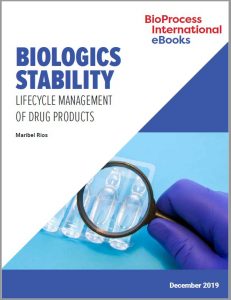 Biologics Stability: Lifecycle Management of Drug Products
Biologics Stability: Lifecycle Management of Drug Products
The biomanufacturing industry’s increasing attention to risk mitigation through quality by design (QbD) and the emergence of complex therapeutic modalities have driven the need for a lifetime-management approach to assuring drug product stability. To that end, industry guidelines have been (or are being) developed to guide the industry toward a “holistic approach” to conducting stability assessments. However, not all methods are stability indicating, and many more industry concerns need to be addressed. This BPI eBook offers perspectives on ICH Q12 guidelines and the upcoming USP <1049.1> general chapter. It also surveys advancements in analytical technologies that could provide better drug product stability testing.
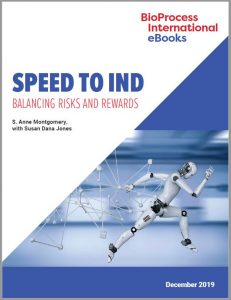 Speed to IND: Balancing Risk and Reward
Speed to IND: Balancing Risk and Reward
With so many biopharmaceuticals obtaining breakthrough or fast-track designations, companies that use accelerated strategies to be first in human studies can be left with significant quality and manufacturing challenges that must be solved later on. Despite regulatory encouragement to create solid design spaces and define parameters according to quality by design (QbD), those may go by the wayside given the pressures of speed. The reward is the investigational new drug (IND) application itself — but if companies lock in subpar processes at that stage while trying to speed to IND, they could get stuck with them. In this eBook, BPI’s editor in chief discusses the pros and cons of timeline acceleration in early development with Susan Dana Jones, senior vice president of product development at Harpoon Therapeutics. Speed at all stages can bring earlier achievement of development milestones (and ultimately return on investment sooner), but going too fast can leave gaps in process understanding and scalability that must be addressed.
Addressing Production Complexities: Strategies for Working with Difficult and Susceptible Proteins
All proteins are complex — but some are more complex than others, particularly when it comes to recombinant protein expression and production in commercial quantities. What works in a research laboratory to make a milligram of pure protein for study won’t necessarily work on a manufacturing floor to make kilogram batches for drug-product formulation. An increasing number of technological options are available, however, from a simple switch in expression host or adding folding steps in downstream processing to special genetic modifications and tagging to cell-free synthesis. High-throughput screening, design-of-experiments, and other analytical advancements are offering developers the means to discover and test possible solutions to the problem of complex protein production. In this eBook, BPI’s senior technical editor highlights several upstream strategies and technologies available to companies dealing with problem proteins. Specific innovations include engineering solutions from Thermo Fisher Scientific, MaxCyte, Cell Culture Company, LifeSensors, Lucigen, Arbor Biosciences, New England Biolabs, and more.
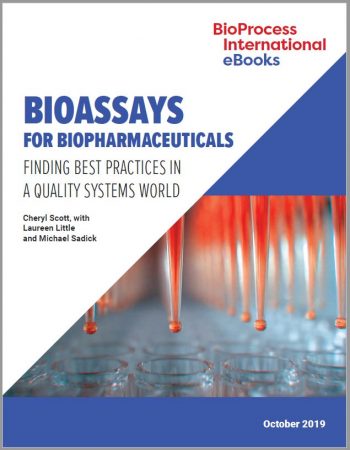 Bioassays for Biopharmaceuticals: Finding Best Practices in a Quality Systems World
Bioassays for Biopharmaceuticals: Finding Best Practices in a Quality Systems World
Bioassays are complex and challenging experiments to run reliably with accurate and dependable results. Consistent performance requires a controlled environment and qualified reagents; skilled analysts who understand cell physiology, regulatory requirements, and the latest techniques; and assay protocols that are intelligently developed, characterized, and validated. Here, BPI’s senior technical editor discusses bioassay best practices with representatives of the Biopharmaceutical Emerging Best Practices Association (BEBPA) organization. Topics span quality by design, assay validation, cell banking, potency testing and host-cell protein monitoring, and special considerations for biosimilars and regenerative medicine.
 Automation: The Value of Plug-and-Play Automation in Single-Use Technology
Automation: The Value of Plug-and-Play Automation in Single-Use Technology
The biopharmaceutical industry’s movement away from large-scale, fixed-tank facilities to flexible facilities featuring single-use technologies (SUTs) has demonstrated the value of modular equipment and agile process design. SUTs have proven to be clear advantages to end users because those technologies enable quick facility build and changeover times. But linking SUT equipment with equally flexible automative technology has been difficult. Herein a group of automation experts from the BioPhorum Operations Group (BPOG) elaborate “plug-and-play” principles and introduce a supervisory control system that can standardize bioprocess communication protocols and reduce equipment startup or process changeover validation time (GMPs).
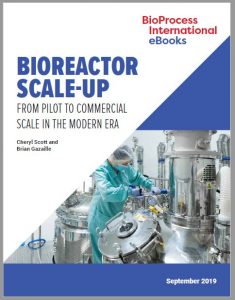 Bioreactor Scale-Up: From Pilot to Commercial Scale in the Modern Era
Bioreactor Scale-Up: From Pilot to Commercial Scale in the Modern Era
Upstream bioproduction always has begun with laboratory systems producing limited amounts of product for test purposes, then those bioprocesses are scaled up to make more product more efficiently for larger clinical trials — and ultimately commercial distribution. With the advent of single-use technology and continuous processing, how have scale-up approaches changed in recent years, specifically at the pilot-to-production level? In this online exclusive, BPI editors review the science and technology affecting decisions made at this stage of process development, with a focus on bioreactors and flow geometry, based on conversations with industry experts as well as a review of recent conference talks and literature.
 Autologous Cell Therapies: Commercialization Strategies
Autologous Cell Therapies: Commercialization Strategies
Autologous cell therapies are derived from a patient’s own stem cells, typically collected from bone marrow. Those cells are then cultured, expanded, and reinfused back into the patient. Unlike allogeneic cell therapies, this process is repeated for each dose and for one patient. The one-to-one process carries several challenges to commercialization, including high development costs, the need to control the risks of manual processing, and compliance with strict timelines.
This eBook presents two perspectives on addressing these challenges. The first article is an interview with George Goldberger from Cell One Partners, a company experienced in consulting biomanufacturers in the development and manufacture of cell and gene therapies. He discusses process challenges, costs, logistics, technologies, and need for innovation for autologous cell therapies. In the second article, Lynn O’Donnell, clinical associate professor of hematology and director of the Cell Therapy Laboratory at The Ohio State University’s James Cancer Hospital and Solove Research Institute, provides her perspective on the clinical side of autologous therapies. She discusses the importance of coordinating therapy development and administration, controlling ancillary material costs, and easing patient burdens.
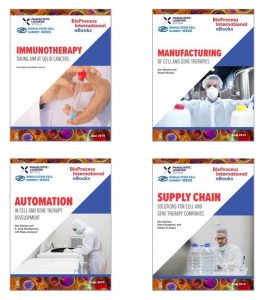 Industrializing Advanced Therapies
Industrializing Advanced Therapies
Phacilitate Leaders World and BioProcess International joined forces to create a special four-part eBook series dedicated to Industrializing Advanced Therapies.
This educational platform has been designed to provide you with insight, information, and perspective necessary to stay ahead of the cell and gene therapy development and process curve.
 Allogeneic Cell Therapies Commercialization Strategies
Allogeneic Cell Therapies Commercialization Strategies
Manufacturers of allogeneic cell therapies face development and commercialization challenges unlike those of traditional cell therapies. In a discussion with Phil Vanek of GE Healthcare, we outline several of the key challenges of processing these products and bringing them to market. Approaches for reducing development costs and lowering pricing are highlighted, and a separate analysis presents three pricing models specific for allogeneic “off the shelf” cell products.
 Biopharmaceutical Characterization, Part 2: Applications and Strategies for Diverse Products — A Conference Report
Biopharmaceutical Characterization, Part 2: Applications and Strategies for Diverse Products — A Conference Report
Last fall, KNect365 brought together more than 250 analytical specialists to discuss biological assays and characterization of well-characterized biologics in Rockville, MD. Speakers from the US Food and Drug Administration joined experts from leading biopharmaceutical companies, service providers, and consultancies for case studies, regulatory interactions, sharing perspectives, and learning about emerging technologies. Part 1 of this report in January 2019 focused on the bioassay section of the meeting. Here in Part 2 sponsored by Sartorius, BPI’s senior technical editor reports on the “Well-Characterized Biologics” tracks. As you make plans for attending conferences this fall, consider the next installment of this series in Reston, VA, on 11–13 November 2019 — and contribute to the ongoing discussions.
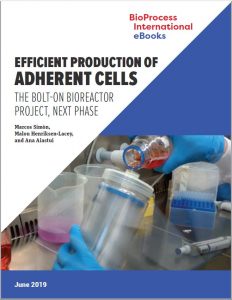 Efficient Production of Adherent Cells – The Bolt-On Bioreactor Project, Next Phase
Efficient Production of Adherent Cells – The Bolt-On Bioreactor Project, Next Phase
In this exclusive eBook, the authors update developments in The Bolt-on Bioreactor (BoB) project. The BoB project was launched with an objective of bringing to the market an efficient bioreactor for culturing adherent cells. In 2015, BioProcess International published a four-part series of articles about their work, in which they identified four challenges that needed be addressed to succeed: volumetric productivity, process automation, containment and sterility, and process economics. These updates include the entrepreneurial venture the team has embarked upon, system design updates, and future plans.
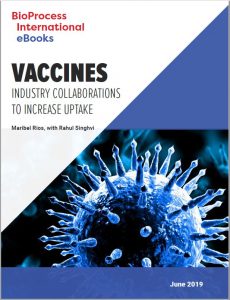 Vaccines – Industry Collaborations to Increase Uptake
Vaccines – Industry Collaborations to Increase Uptake
In this exclusive eBook, BioProcess International’s managing editor, Maribel Rios talks to Rahul Singhvi, chief operating officer at Takeda about how vaccine developers and manufacturers are partnering with private and government agencies to increase global vaccine uptake. The areas of focus in their discussion include challenges with production capacity, distribution, safety, and accessibility. Singhvi also shares how the implementation of new technologies such as virus-like particles and cell/DNA-based vaccines are helping biomanufacturers take on vaccines for emerging diseases.
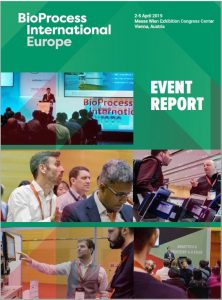 BioProcess International Europe 2019 Event Report
BioProcess International Europe 2019 Event Report
BioProcess International Europe has distinguished itself as a must-attend event for industry decision makers around the world. While complementing and connecting to content delivered at all BPI events, this conference delivers unique and applicable information not presented anywhere else.
In this exclusive event report, BioProcess International’s publisher and senior technical editor offer their perspectives on this year’s meeting in Vienna, Austria, with a program overview and exploration of themes that arose from the sessions and talks: from accelerated cell-line engineering to continuous bioprocessing, new separation/purification platforms and product modalities, and “industry 4.0.”
The editor of BioProcess Insider reports on process intensification and associated challenges. And a group of speakers gets together for an exclusive roundtable discussion of vaccine and gene therapy topics from their dedicated track at BPI Europe.
 Expression Systems — Increasing Productivity and Reducing Costs
Expression Systems — Increasing Productivity and Reducing Costs
Biopharmaceutical manufacturers are facing increasing pressures to improve productivity and reduce time to clinic and market. Increasing productivity begins with selecting the appropriate expression system for each protein. Current efforts to boost expression titers also are focused on implementing selection/screening technologies, engineering Chinese hamster ovary (CHO) expression systems, and accelerating timelines for the development of complex next-generation therapies. BioProcess International asked three representatives of the industry’s leading companies to comment on current expression system technologies and strategies.
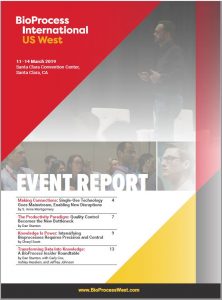 2019 BioProcess International West Event Report
2019 BioProcess International West Event Report
At the BPI West conference in Santa Clara, CA, common themes wove throughout multiple tracks specific to process stages and levels of regulatory scrutiny. The BPI West program brings upstream and downstream experts together into the same sessions based on whether they share early or late-stage concerns. Even though special tracks addressed viral safety and technological advancements this past March, and preconference symposia focused on specific topics, a significant amount of session overlap throughout the week ensured that attendees could mix and mingle while getting exposed to one another’s work. Commonalities emerged from these discussions as vaccine makers rubbed elbows with monoclonal antibody (MAb) developers and gene/cell therapy pioneers — and cell culture biologists with downstream process engineers and formulators.
In this eBook, editors of BioProcess International and BioProcess Insider examine the common themes of process intensification and continuous processing, automation and process control, analytics and characterization, and the importance of data management to all these.
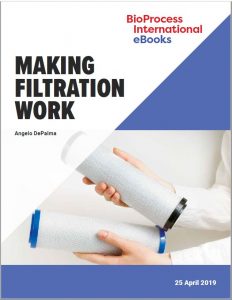 Making Filtration Work
Making Filtration Work
Steady improvements in batch-fed cell culture have led to bottlenecks in downstream processing. Filter suppliers are working to improve available tools for purifying therapeutic proteins, to wring every possible efficiency out of those tools, and to make them operate together harmoniously. The combination of high titers and high-value products places a premium on preventing yield loss. Bioprocessors want to optimize filtration primarily for cost reasons.
In this eBook, author Angelo DePalma discusses financial aspects, clarification/harvest and virus filtration options, and innovations in filtration for downstream bioprocessing is covered with experts from the biopharmaceutical industry. They highlight how each stakeholder can work toward solving the case of upstream–downstream capacity mismatch.
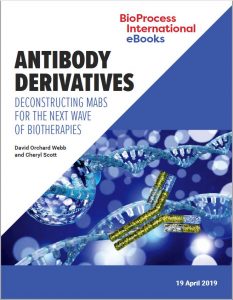 Antibody Derivatives: Deconstructing MAbs for the Next Wave of Biotherapies
Antibody Derivatives: Deconstructing MAbs for the Next Wave of Biotherapies
Although they make up the largest and most successful category of biopharmaceuticals so far, monoclonal antibodies (MAbs) suffer from certain disadvantages. Some companies are addressing those limitations by deconstructing MAb molecules to create new emergent therapeutics. These antibody derivatives include: antibody fusions and fragments, bispecifics, trifunctional antibodies, and more.
This eBook combines market analysis from consultant David Orchard-Webb with technical discussion from BPI cofounder and senior technical editor Cheryl Scott. It also includes commentary from editorial advisor Michiel Ultee and BioProcess Insider editor Dan Stanton, to present a current picture of where these “next-generation” therapeutic proteins stand.
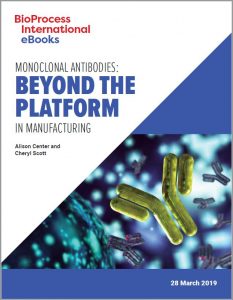 Monoclonal Antibodies: Beyond the Platform in Manufacturing
Monoclonal Antibodies: Beyond the Platform in Manufacturing
The vast majority of monoclonal antibody (MAb) production processes are based on fed-batch Chinese hamster ovary (CHO) cell culture and protein A affinity column chromatography capture. Increasing cost-consciousness — among innovator companies as well as biosimilar makers — has many companies looking “beyond the platform” for less expensive alternatives that may provide better results. Here the BPI editors review some state-of-the-art alternatives in upstream and downstream MAb drug substance bioprocessing as well as drug-product manufacturing.
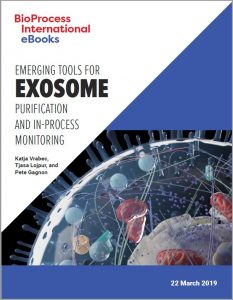 Emerging Tools for Exosome Purification and
Emerging Tools for Exosome Purification and
In-Process Monitoring
This eBook introduces new analytical approaches that enable in-line chromatographic detection of exosomes. One approach can discriminate extracellular vesicles from nonvesicle contaminants, and one potentially can discriminate exosomes from other vesicles. Examples illustrate how they enable development of more effective and better documented purification methods. The special qualifications of monolithic chromatography media for exosome purification are discussed. New process tools designed to accommodate some of the special challenges of exosome purification are introduced.
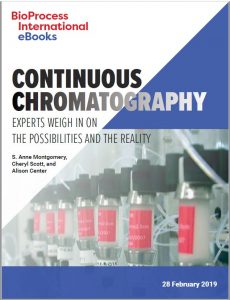 Continuous Chromatography: Experts Weigh in on the Possibilities and the Reality
Continuous Chromatography: Experts Weigh in on the Possibilities and the Reality
Discussions of continuous processing in the biopharmaceutical industry are an important part of current efforts toward intensifying bioproduction and bioprocessing. Biomanufacturers are looking at all components of their development and manufacturing processes for ways to reduce the size of their facilities, lower costs, and increase speed and flexibility of operations. Increasing options for and availability of single-use technologies have been major enablers of myriad attempts to improve efficiencies. Although the general consensus may still be that single-use components are more conducive to continuous upstream than to downstream processing, process intensification efforts to streamline manufacturing operations already have been challenging those assumptions in the past few years. Through new sensors, automation, and process control technologies, biomanufacturers can take advantage of greater connectivity of unit operations (1). Some are implementing hybrid processes (combining both continuous and batch unit operations throughout a manufacturing process), a few are attempting fully continuous unit operations, and many continue to use end-to-end processes based on staggered batch unit operations.
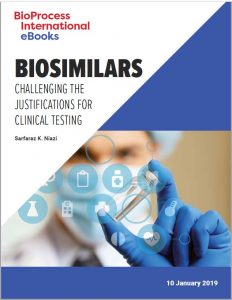 Biosimilars: Challenging the Justifications for Clinical Testing
Biosimilars: Challenging the Justifications for Clinical Testing
The Biologics Price Competition and Innovation Act (BPIA) of 2009, describes the need for clinical trials as follows (1): “(cc) a clinical study or studies (including the assessment of immunogenicity and pharmacokinetics or pharmacodynamics) that are sufficient to demonstrate safety, purity, and potency in one or more appropriate conditions of use for which the reference product is licensed and intended to be used and for which licensure is sought for the biological product.”
However, all the above studies are left to the discretion of the US Food and Drug Administration (FDA). Other requirements not left to the agency’s discretion include the same drug, the same dosage form, a US-licensed comparator, the same indication, the same mode of action (MoA), and current good manufacturing practice (CGMP) compliance.
 Messenger RNA Drugs: Engaging the Machinery of Patients’ Cells to Therapeutic Effect
Messenger RNA Drugs: Engaging the Machinery of Patients’ Cells to Therapeutic Effect
Although most of the bioprocess industry has focused on process development for large-molecule formulations (e.g., protein drugs), a growing segment of the industry has been concentrated on other types of biotherapeutics to leverage advances in understanding of immunology and genetic engineering. Such technologies may emerge both as tools for drug manufacturing and at some point, as biopharmaceuticals, biotherapeutics, vaccines, and cell and gene therapies, themselves. What brings mRNA research to BioProcess International’s attention is the increasing interest turned toward therapeutic applications, as explored in this review of current work toward that goal.
 Biopharmaceutical Characterization,
Biopharmaceutical Characterization,
Part 1: Biological Assays — A Conference Report
In late October 2018, KNect365 brought together more than 250 analytical specialists to discuss characterization of well-characterized biologics in Rockville, MD. Speakers from the US Food and Drug Administration joined experts from leading biopharmaceutical companies, service providers, and consultancies, including BPI editorial advisor Nadine Ritter (president and analytical advisor of Global Biotech Experts). She began the final day moderating a special town-hall session where audience members could pose their regulatory questions to a panel of FDA reviewers, and she ended that day serving on a panel herself to address the topic of bioassays for cell and gene therapies.
 Using Modern In Situ Analytics and PAT for Automated Feedback Control of Critical Process Parameters
Using Modern In Situ Analytics and PAT for Automated Feedback Control of Critical Process Parameters
The need for advanced control strategies for bioprocessing and biomanufacturing is growing, and several manufacturers already have leveraged new automation and software solutions for bioprocess monitoring and control. New bioprocess market dynamics and modalities are driving automation forward. A number of technologies and adaptations are now available for bioprocessing that are designed to help enable automation and enable online analytics for real-time monitoring. Measuring critical process parameters with highly specific and scalable technologies that are adaptable to all bioreactor formats creates a strong foundation for advanced automation in bioprocessing with process analytical technologies integration.
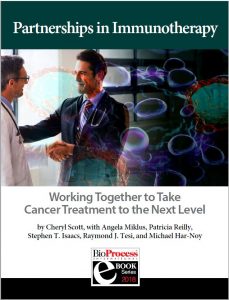 Partnerships in Immunotherapy: Working Together to Take Cancer Treatment to the Next Level
Partnerships in Immunotherapy: Working Together to Take Cancer Treatment to the Next Level
Biopharmaceuticals are a particularly complex expression of medicine — and immunotherapies perhaps even more so. As treatments, these products themselves often also need “partners” of a kind: e.g., radiation/radiotherapies, traditional MAbs, and chemotherapies. Just as this field of endeavor requires the input and expertise of many different disciplines — from medical researchers to process engineers, clinicians to business leaders, and market experts to policy makers — this discussion of the topic of partnerships in immunotherapy brings together different experts in the field. BPI’s senior technical editor introduces contributions by Angela Miklus of Datamonitor Healthcare (an Informa company), Stephen T. Isaacs of Aduro Biotech, Raymond Tesi of INmune Bio, Michael Har-Noy of Immunovative, and Patricia Reilly of Pharma Intelligence (an Informa business).
 Inactivation of Enveloped Viruses: Seeking Alternatives to a Problematic Surfactant
Inactivation of Enveloped Viruses: Seeking Alternatives to a Problematic Surfactant
Triton X-100 detergent makes an interesting case study in bioprocess sustainability strategy. Also known as octylphenol ethoxylate (OPE), this nonionic surfactant has many uses in biopharmaceutical research and development. It serves as a vaccine excipient and most notably a virus-inactivation agent in downstream processing. Despite a long history of industrial use and an established safety profile, OPE has been listed in Europe as a “substance of very high concern” because it recently has been shown to degrade in the environment to yield an endocrine disruptor. Consequently, many users are looking for alternatives — especially for high-volume uses such as viral inactivation of large-scale product streams. In this exclusive eBook, BPI’s senior technical editor reviews the problem and potential solutions in the works, including discussion with scientists at Bayer and Biogen.
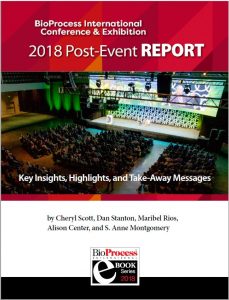 BioProcess International Conference and Exhibition 2018 Postevent Report: Key Insights, Highlights, and Take-Away Messages
BioProcess International Conference and Exhibition 2018 Postevent Report: Key Insights, Highlights, and Take-Away Messages
From the global shift in demographics to increased efficiencies in chromatography media, change is constant within the bioprocessing industry and a major reason delegates flock to the annual BPI Conference and Exhibition. As a place to get an overview of the hot topics affecting this industry, the meeting brings together key aspects of bioprocessing — therapeutic modalities, cells, expression systems, upstream production, downstream processing, development, and manufacturing — with digital integration and the increasing importance of analytics.
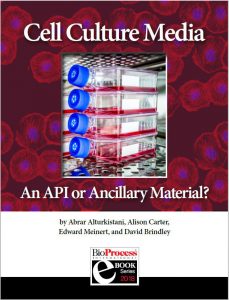 Cell Culture Media: An Active Pharmaceutical Ingredient or Ancillary Material?
Cell Culture Media: An Active Pharmaceutical Ingredient or Ancillary Material?
A wide range of reagents and materials such as antibodies, growth factors, and enzymes are used in their manufacturing processes. Such necessary materials are administered through a cell culture medium. Active pharmaceutical ingredients (APIs) are the main ingredients that make products therapeutic. Ancillary materials (AMs) and raw materials (RMs) are essential components used during production but are not supposed to be present in final products. Some advances in cell-based therapies have revealed inconsistencies and lack of regulation in classifying materials that are used to produce these products as RMs, AMs, and APIs. Clear guidelines and regulations are needed regarding RMs and AMs in cell-based therapies.
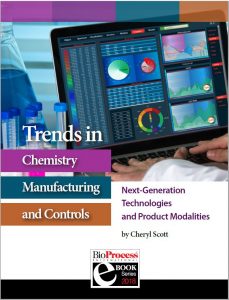 Trends in Chemistry, Manufacturing, and Controls: Next-Generation Technologies and Product Modalities
Trends in Chemistry, Manufacturing, and Controls: Next-Generation Technologies and Product Modalities
New technologies bring new regulatory challenges. The biopharmaceutical industry must be cautious in its implementation of new scientific ideas and technology platforms — no matter how promising those might be. Regulators will look skeptically on any claim that isn’t backed up by good data, and with no solid history of successful use to build on, a company must have all the answers itself. How do compliance professionals anticipate what kinds of questions reviewers will ask when the time comes — and how can those in development laboratories and manufacturing suites best be prepared to respond to them? With all that in mind, this eBook addresses a number of new approaches to the regulation-defined areas of chemistry, manufacturing, and controls (CMC) for protein biologics.
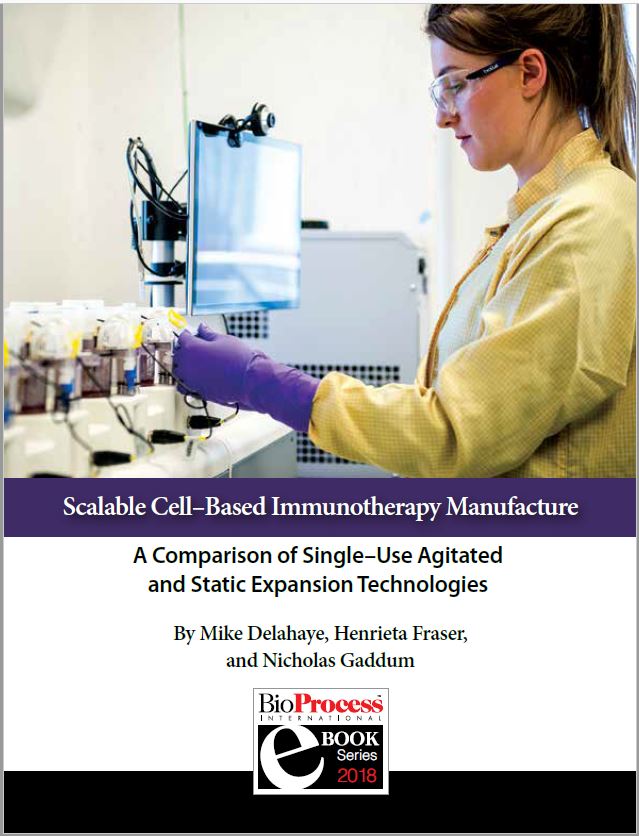 Scalable Cell-Based Immunotherapy Manufacture: A Comparison of Single-Use Agitated and Static Expansion Technologies
Scalable Cell-Based Immunotherapy Manufacture: A Comparison of Single-Use Agitated and Static Expansion Technologies
Early clinical results indicate that personalized autologous immunotherapies could revolutionize cancer treatment. However, challenges lie in the realization of cost driven, scalable cell therapy (CT) manufacturing strategies for generating sufficient therapies. A strategical aim at The Cell and Gene Therapy Catapult (CGT) is collaborative development of next-generation autologous manufacture strategies. This study evaluates the expansion potential of stirred-tank bioreactors for immunotherapy manufacture and compares that to current state-of-the-art static and wave-agitated cultures.
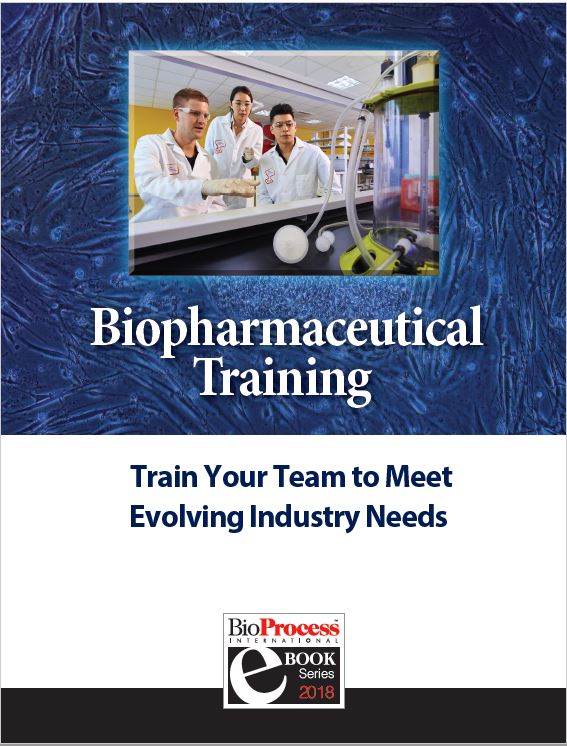 Biopharmaceutical Training – Train Your Team to Meet Evolving Industry Needs
Biopharmaceutical Training – Train Your Team to Meet Evolving Industry Needs
Welcome to this year’s focus on industry training programs. In the past three years we’ve brought this information to you in several forms: as a full supplement issue (2016), a featured report (2017) – and now this ebook. Each program that we’ve profiled offers its unique approach to training present and future biotechnologists. The best of the programs offer hands-on training with current equipment provided by supplier partners and with up-to-date approaches to documentation and regulatory requirements. Many university- and community-college–based programs, once lacking in practical, GMP training, now also benefit from a wealth of hands-on manufacturing experience toward resolving real-world issues.
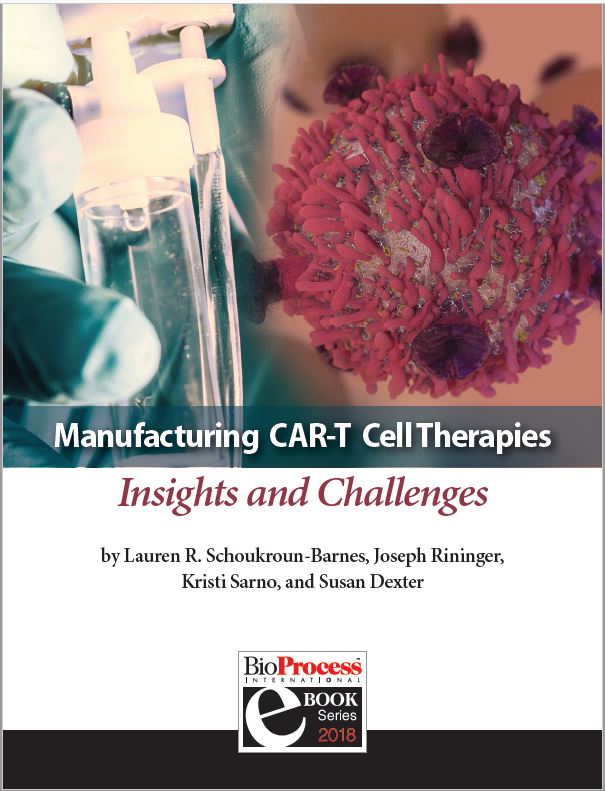 Manufacturing CAR-T Cell Therapies — Insights and Challenges
Manufacturing CAR-T Cell Therapies — Insights and Challenges
The rapid evolution and clinical success of T-cell immunotherapies is an exciting advance in the war on cancer. Chimeric antigen receptor T-cell (CAR-T) therapy is emerging as the most studied treatment in T-cell immunotherapy and is the basis for many ongoing clinical trials. For better understanding of the manufacturing difficulties, the authors analyzed technical and economic challenges encountered by CAR-T contract manufacturers and innovators. The analysis reveals that further refinement and implementation of an automated closed system could facilitate expansion of CAR-T therapies into routine cancer treatment.
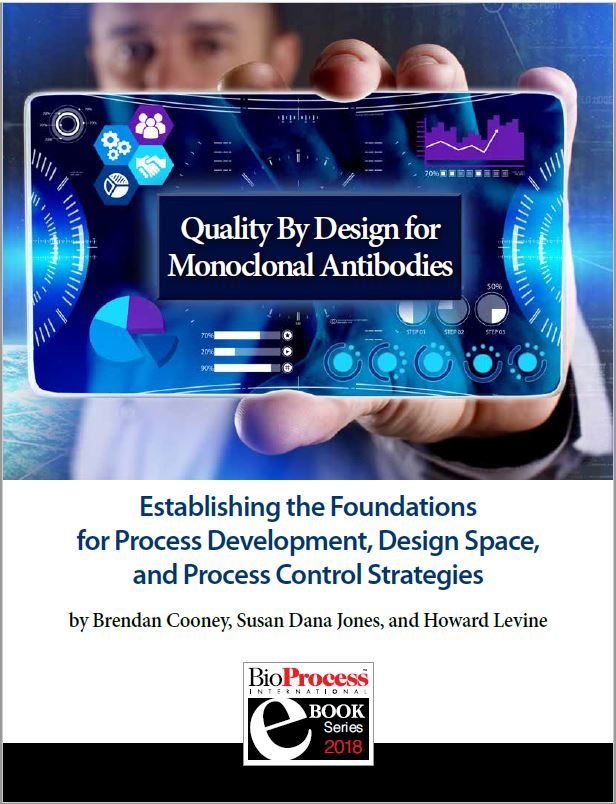 Quality By Design for Monoclonal Antibodies — Establishing the Foundations for Process Development, Design Space, and Process Control Strategies
Quality By Design for Monoclonal Antibodies — Establishing the Foundations for Process Development, Design Space, and Process Control Strategies
This article, combining parts 1 and 2 from BPI’s June and September 2016 issues, presents early steps in process development, including defining a target product profile (TPP), a quality target product profile (QTPP), and critical quality attributes (CQAs). It concludes by focusing on establishing a design space and optimizing process characterization through risk assessment and a well-defined control strategy. FDA’s 2002 initiative Pharmaceutical CGMP for the 21st Century: A Risk-Based Approach sought to improve interactions between pharmaceutical manufacturers and regulators by focusing on science- and risk-based approaches to development.
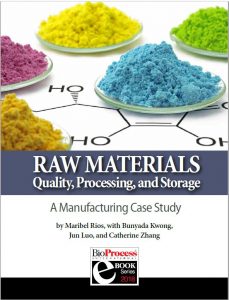 Raw Materials Quality, Processing, and Storage — A Manufacturing Case Study
Raw Materials Quality, Processing, and Storage — A Manufacturing Case Study
Raw material storage, handling, and processing are essential to ensure high product quality and consistent process performance. Slight variabilities in raw materials (either inherent in the material or through processing) can compromise yield and even result in batch loss. Bunyada Vamnutjinda Kwong, senior engineer of manufacturing sciences, cell culture, at Genentech (Vacaville, CA) shares a manufacturing case study in raw material and storage conditions. It focuses on the current landscape of raw materials, cell culture process flow, the importance of raw materials for cell culture, internal requirements of raw-material handling, and an overview of a case study of how raw material had affected process performance and product quality.
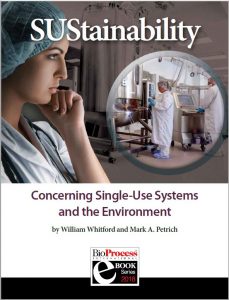 SUStainability: Concerning Single-Use Systems and the Environment
SUStainability: Concerning Single-Use Systems and the Environment
Disposable materials have been used in many aspects of biomanufacturing since muromonab was first launched in 1986. Single-use stirred-tank bioreactors first became commercially available from HyClone in 2004 (1). Despite their demonstrated value to bioprocessing, disposable materials remain the subject of wide-ranging differences of opinion. Discussions of any
technology are healthy and important for identifying areas for improvement, but some hearsay and bold propositions made regarding single-use components and the environment are not always helpful. Sustainability is an important and much-publicized topic, and among both lay people and industrial decision-makers is a tendency to automatically equate “disposable” or “plastic” with an environmental liability. Because so many scientists and engineers are involved in biotechnology, we are hopeful that a true technical analysis of sustainability and single-use systems (SUS) for bioprocessing — thus, SUStainability — will get a fair hearing. This is important because the results of such analysis contradict popular opinion. SUS do provide an environmental advantage over traditional durable manufacturing facilities.
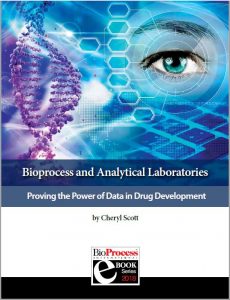 Bioprocess and Analytical Laboratories — Proving the Power of Data in Drug Development
Bioprocess and Analytical Laboratories — Proving the Power of Data in Drug Development
Analytics pervade the entire biopharmaceutical development process — from protein characterization through biomanufacturing process optimization to final-product formulation and clinical testing. Every technical article in BPI requires data to back up the statements made, whether the topic is upstream/production, downstream processing, product development, or otherwise focused. And never mind publishing: Even more detailed documentation is required for regulatory submissions. If a company can’t back up the choices made and results obtained in development, manufacturing, and testing of its biopharmaceutical product, then that drug will never find its way to market or the patients who might have benefited from it.
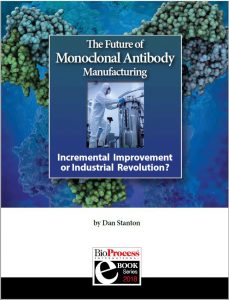 The Future of Monoclonal Antibody Manufacturing — Incremental Improvement or Industrial Revolution?
The Future of Monoclonal Antibody Manufacturing — Incremental Improvement or Industrial Revolution?
Monoclonal antibody manufacturing is at a crossroads. Biomanufacturers could continue exploring new technologies and fine-tuning proven systems such as mammalian cell expression systems in stirred-tank bioreactor fed-batch cultures. But some experts say an opportunity is arising to turn the industry on its head by taking lessons from other branches of bioprocessing, such as the industrial enzyme sector.
Drug makers are criticized often these days for the high prices of their products. The lay media, governments, payers, and patients themselves all have voiced their share of grievances against “Big Biopharma’s” pricing strategies.
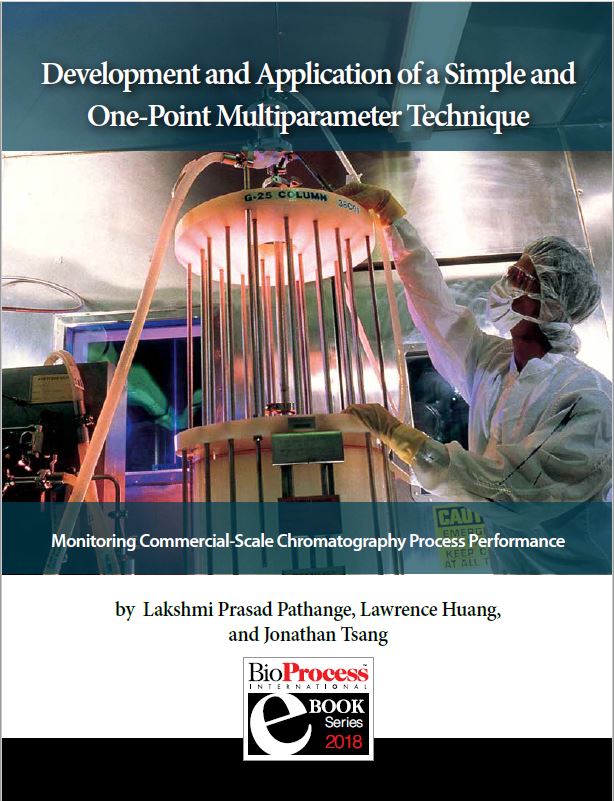 Development and Application of a Simple and One-Point Multiparameter Technique — Monitoring Commercial-Scale Chromatography Process Performance
Development and Application of a Simple and One-Point Multiparameter Technique — Monitoring Commercial-Scale Chromatography Process Performance
In commercial-scale biopharmaceutical manufacturing, downstream chromatography steps are still a bottleneck and contribute to significant operational costs. Some of those costs are inherent (e.g., resins, large buffer quantities, and cleaning) whereas others are avoidable (e.g., product loss due to rejected lots or deviations that result in production downtime). Maintaining efficient and robust chromatography process performance is therefore critical for minimizing operating costs. In this eBook, the authors introduce a simple and one-point multiparameter technique (SOP-MPT) for monitoring chromatographic process performance.
 The Commercial Expression Systems Market: What Has Changed in the Past Decade
The Commercial Expression Systems Market: What Has Changed in the Past Decade
A decade ago, BioPlan Associates prepared the findings of its 2008 directory of expression system technologies that were being promoted or considered likely to be suitable for commercial licensing for biopharmaceutical manufacturing. Due in part to the relatively slow advances in this critical area of bioprocessing, this study remains perhaps the only directory of biopharmaceutical-relevant expression systems available for licensing. In this eBook, author Ronald A. Rader discusses aspects of related bioprocessing technologies that have and have not changed in the past decade.
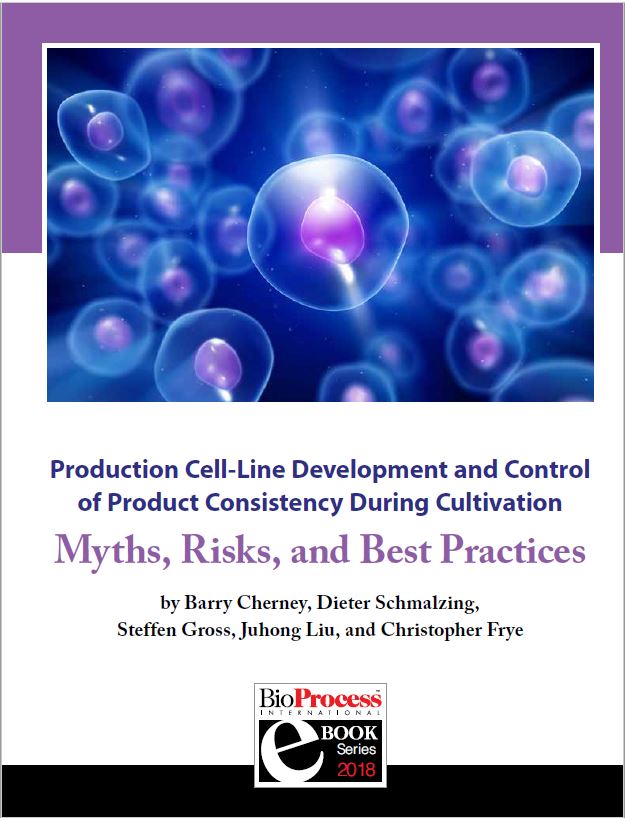 Production of Cell-Line Development and Control of Product Consistency During Cultivation:
Production of Cell-Line Development and Control of Product Consistency During Cultivation:
Myths, Risks, and Best Practices
Health authorities are requesting substantial details from sponsors regarding practices used to generate production cell lines for recombinant DNA–(rDNA) derived biopharmaceuticals.
Authorities also are asking for information about the clonality of master cell banks (MCBs) and control strategies to minimize genetic heterogeneity. Such requests are prompted by recent reports indicating “nonclonality” for certain production cell lines. To address these and related issues, the CASSS CMC Strategy Forum on “Production Cell Line Development and Control of Product Consistency During Cell Cultivation: Myths, Risks and Best Practices,” was held 23 January 2017 in Washington, DC.
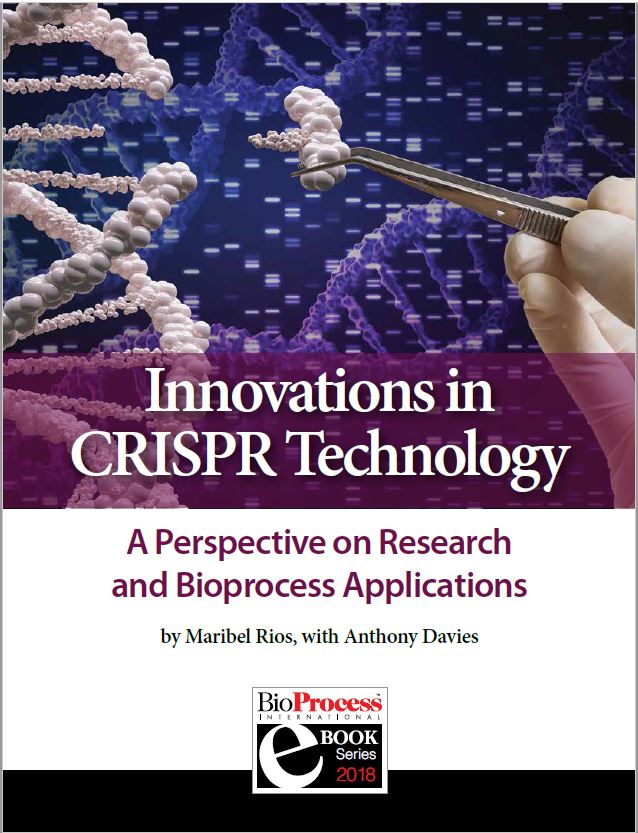 Innovations in CRISPR Technology: A Perspective on Research and Bioprocess Applications
Innovations in CRISPR Technology: A Perspective on Research and Bioprocess Applications
One of the fastest growing areas in genome engineering is research using the powerful editing tool of clustered regularly interspaced short palindromic repeats (CRISPR). When paired with the Cas9 (CRISPR-associated protein 9), an RNA-guided DNA endonuclease enzyme from Streptococcus pyogenes, the site-specific prokaryotic immune system can be used to cut and manipulate DNA strands in cells of patients with genetic diseases to treat, or in some cases, prevent such diseases. Within the past couple of years, CRISPR has been shown to improve signficantly the engineering of chimeric antigen receptor T cells (CAR-T cells) and to deliver CAR to specific sites within T cells. To gain a perspective on how the use of CRISPR is affecting research in genetic disease and may reduce costs in bioproduction, Maribel Rios, managing editor of BioProcess International, spoke with Anthony Davies, PhD, chief executive officer and founder of Dark Horse Consulting.
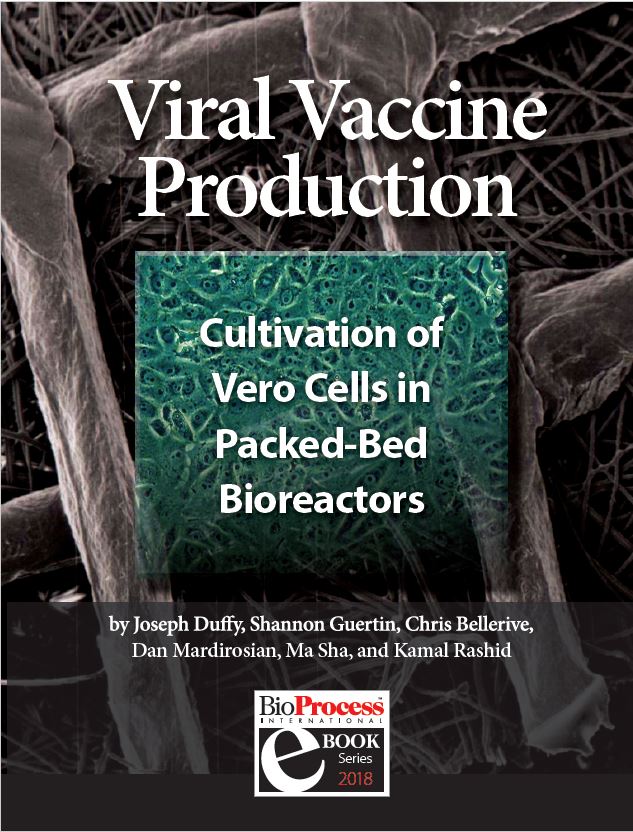 Viral Vaccine Production: Cultivation of Vero Cells in Packed-Bed Bioreactors
Viral Vaccine Production: Cultivation of Vero Cells in Packed-Bed Bioreactors
Using mammalian cell culture for viral vaccine production has advantages over production in embryonated chicke eggs, including: a shorter lead time, a production process that can be more tightly controlled, and reduced risk of microbial contamination. Vero cells are anchorage-dependent cells, and commonly grown in roller bottles or T-flasks. Stirred-tank bioreactors provide advantages in process development and industry-scale production. In stirred-tank bioreactors, Vero cells are typically grown on microcarriers. Fibra-Cel disks are an alternative attachment matrix because they provide a three-dimensional environment that protects cells from damaging shear forces. However, such disks have not been tested for the cultivation of Vero cells. The authors of this eBook tested cultivation of Vero cells in a benchtop single-use and glass bioreactors with a packed bed made of Fibra-Cel disks.
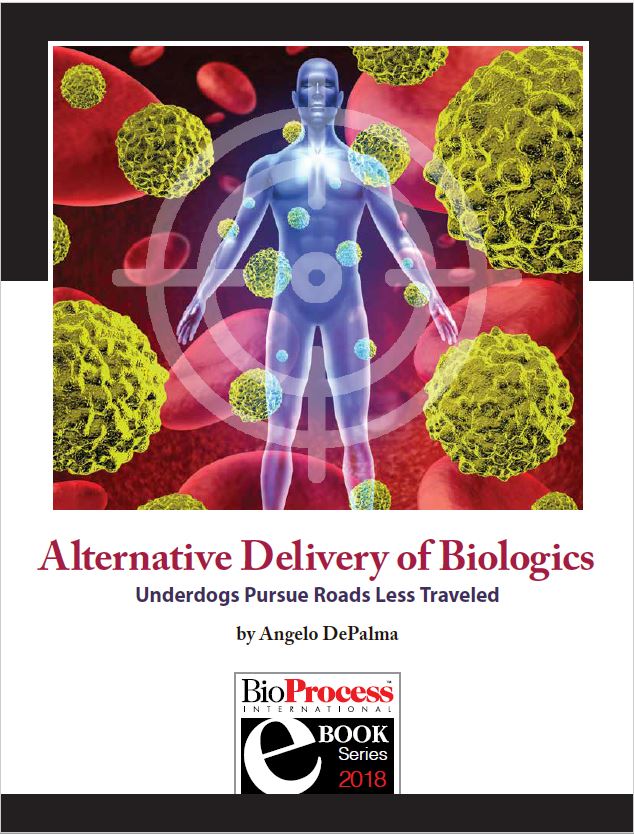 Alternative Delivery of Biologics — Underdogs Pursue Roads Less Traveled
Alternative Delivery of Biologics — Underdogs Pursue Roads Less Traveled
A number of failures in development of noninjectable delivery methods for therapeutic proteins have caused numerous development programs to crash and burn along with investors’ hopes, dreams, and cash. Most everyone reading BioProcess International is familiar with the issues and challenges: Needles hurt and involve risks to both caregivers and patients. Injections often require administration by trained personnel in specialized settings. But alternative forms of delivery are fraught with greater challenges related to dosing, bioavailability (particularly for oral dosing), and inherent difficulties in formulating fragile protein drugs. Alongside human and ergonomic factors, these issues put the industry into (as Oliver Hardy might have said) “a fine mess” that has defied the efforts of the best engineers in the business. This eBook includes discussion of the various forms of alternative delivery methods currently under consideration for biologics: inhalation, edible, sublingual, microneedle, and implants.
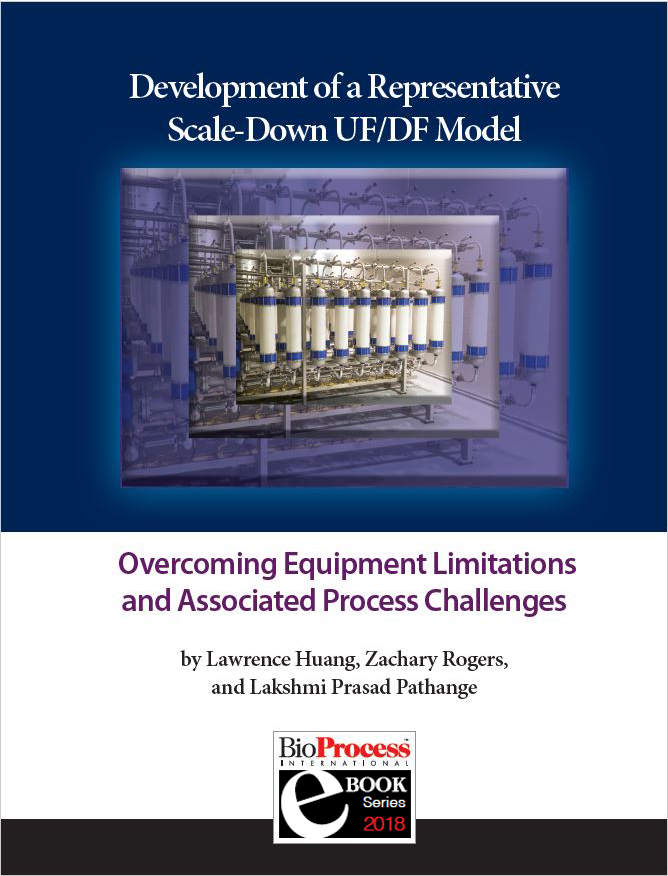 Development of a Representative Scale-Down UF/DF Model: Overcoming Equipment Limitations and Associated Process Challenges
Development of a Representative Scale-Down UF/DF Model: Overcoming Equipment Limitations and Associated Process Challenges
Scale-down models (SDM) are physical, small-scale models of commercial-scale unit operations or processes that are used throughout the biopharmaceutical industry for validation studies, commercial deviation investigations, and postapproval process improvements. To support these studies, regulatory guidelines state that SDMs should be representative of the commercial process. For some downstream unit operations such as column chromatography, developing a representative SDM is straightforward because a linear scale-down approach can be used. However, developing a representative SDM for other downstream unit operations such as ultrafiltration/diafiltration (UF/DF) is more difficult because of scale-down equipment limitations and associated process challenges. The authors present a systematic (stepwise), science-based approach used to overcome these limitations during the development of a UF/DF SDM.
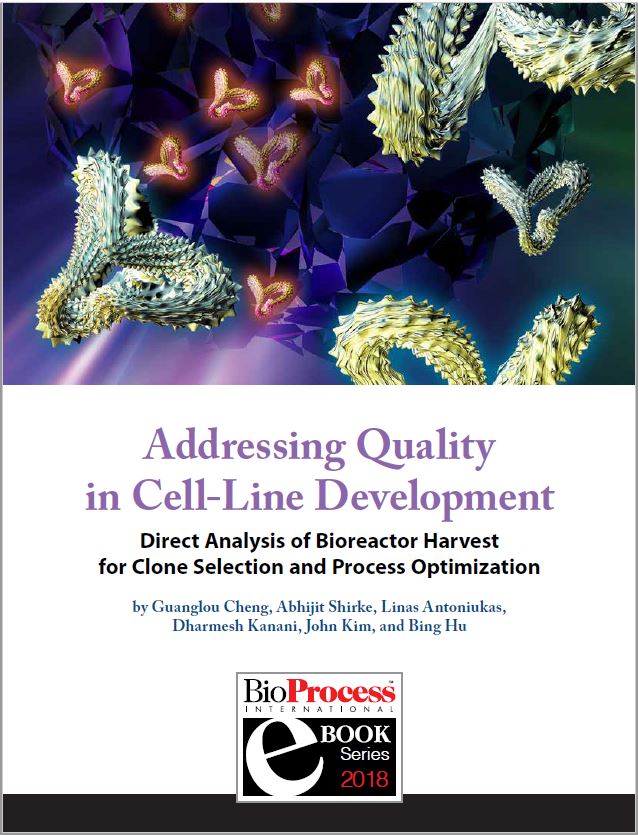 Addressing Quality in Cell-Line Development — Direct Analysis of Bioreactor Harvest for Clone Selection and Process Optimization
Addressing Quality in Cell-Line Development — Direct Analysis of Bioreactor Harvest for Clone Selection and Process Optimization
Therapeutic monoclonal antibodies mostly are manufactured using mammalian cells cultured in a bioreactor for two to three weeks. Often the bioreactor harvest is considered too “dirty” to be tested with any analytical method. The authors of this eBook explored direct analysis of bioreactor harvest using capillary sodium-dodecyl sulfate (cSDS) electrophoresis, size-exclusion high-performance liquid chromatography (SE-HPLC), and surface plasmon resonance (SPR) assays. The results provided valuable information and guidance on immunoglobulin G (IgG) integrity and quality during clone-selection and bioreactor scale-up.
 Of Microbrews and Medicines: Understanding Their Similarities and Differences in Bioprocessing Can Help Improve Yields and Quality While Reducing Cost
Of Microbrews and Medicines: Understanding Their Similarities and Differences in Bioprocessing Can Help Improve Yields and Quality While Reducing Cost
Whatever attracts a scientist or engineer to making medicines and/or craft brews, a surprising number of principles hold true for both bioprocesses despite the significant differences between biopharmaceutical and brewing practices. Author Lisa J. Graham examines how different software and hardware applications can provide the scientific insight required for success with either type of bioprocessing. Techniques for developing both process analytical technology (PAT) and novel data analytics approaches could cross over between these biotechnology industries.
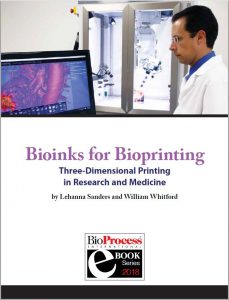 Bioinks for Bioprinting: Three-Dimensional Printing in Research and Medicine
Bioinks for Bioprinting: Three-Dimensional Printing in Research and Medicine
Three-dimensional (3D) printing is on the precipice of becoming a useful technology in biomanufacturing, research, and clinical medicine. 3D cell culture provides a biomimetic model of cell systems for many applications including cell/tissue models and constructs for basic/medical research, product testing, and regenerative medicine. 3D bioprinting (3DBP) uses printing techniques to create 3D structures such as living tissue. 3DBP technologies have been used to generate organ-on-a-chip systems for modeling tissue units of function through incorporating both 3D cell systems and fluid flow on a microscale.
In this exclusive eBook, authors from Advanced Solutions Life Sciences and GE Healthcare describe the state-of-the-art in 3DBP. The authors discuss some challenges facing the wider adoption of bioprinting, as well as the promise of this emerging technology.
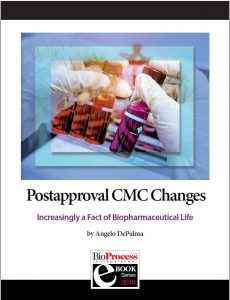 Postapproval CMC Changes: Increasingly a Fact of Biopharmaceutical Life
Postapproval CMC Changes: Increasingly a Fact of Biopharmaceutical Life
Postapproval changes (PACs) to chemistry, manufacturing, and controls (CMC) were initiated reluctantly and carefully in the era of “the process is the product.” Today, CMC PACs are a normal part of the biopharmaceutical industry business. In this exclusive eBook, BPI covers the reasons for filing CMC postapproval changes, the global regulatory processes, safety signals in pharmacovigilance, raw materials changes and the degree of testing needed, some common assumptions that need to be more thoroughly considered, and unofficial changes.
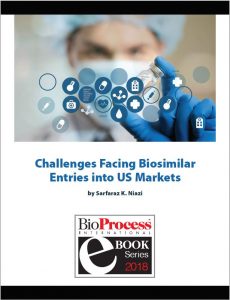 Challenges Facing Biosimilar Entries into US Markets
Challenges Facing Biosimilar Entries into US Markets
Since 2009, the European regulatory agency (EMEA) has approved 31 biosimilar products. In the same timeframe, the U.S. Food and Drug Administration has licensed only six products (under PHS 351k), and approved one product under FD&C 505(b). Why the discrepancy? What are the critical challenges and obstacles impeding biosimilar approvals in the US? Sarfaraz Niazi, PhD, SI, FRSB, FPAMS, FACB, founder of Karyo Biologics, and adjunct professor at the University of Illinois provides insight into these questions and many other factors.
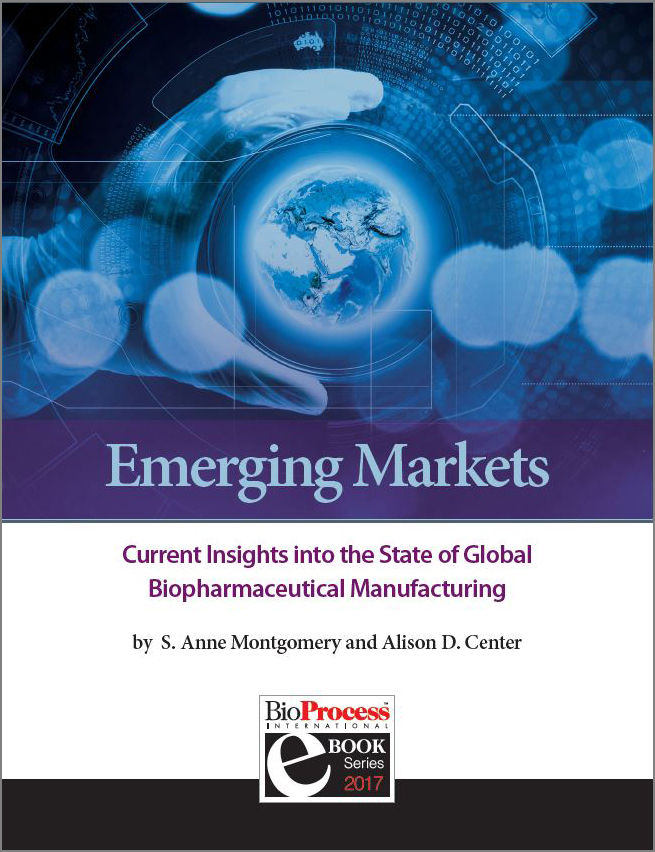 Emerging Markets: Current Insights into the State of Global Biopharmaceutical Manufacturing
Emerging Markets: Current Insights into the State of Global Biopharmaceutical Manufacturing
Opportunities for establishing strong biopharmaceutical capabilities are expanding across the globe. This e-book seeks to encapsulate the current state of emerging markets/countries, tracing key elements above and offering examples to show where (in the world) the biopharmaceutical industry is expanding and securing its footholds.
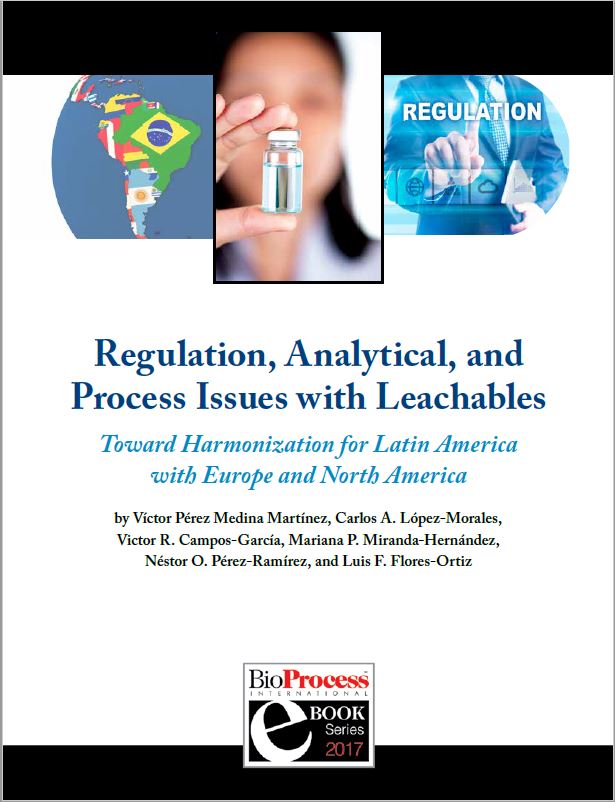 Regulation, Analytical, and Process Issues with Leachables: Toward Harmonization for Latin America with Europe and North America
Regulation, Analytical, and Process Issues with Leachables: Toward Harmonization for Latin America with Europe and North America
In this exclusive editorial eBook, authors from Mexico describe some issues related to plastic leachables in the context of ongoing efforts to harmonize regulations between the United States, European Union, and Latin America. They offer solutions in accordance to the “state in the art techniques” to fulfill this important gap in pharmaceutical industry.
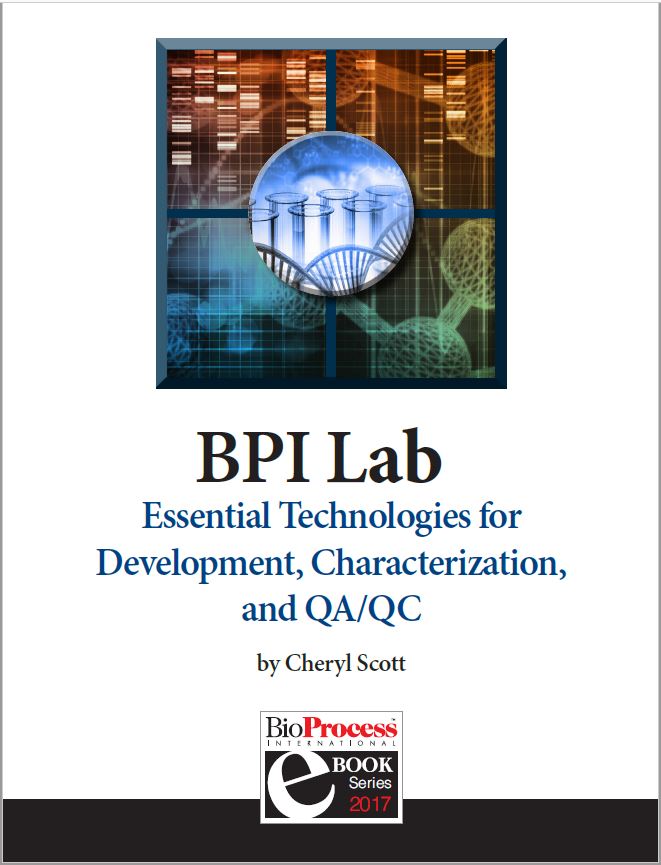 BPI Lab: Essential Technologies for Development, Characterization, and QA/QC
BPI Lab: Essential Technologies for Development, Characterization, and QA/QC
There’s a secret hiding in plain sight: many analytical methods and technologies initially designed for pre-clinical development have equally important applications in commercial development. BioProcess International and BioTechniques, partnered to create this special eBook, highlighting and detailing fourteen analytical technologies that provide laboratory technicians and scientists with vital information to help project managers and engineers make educated decisions that ultimately affect every company’s bottom line.
 Extractables and Leachables: Standardizing Approaches to Manage the Risk
Extractables and Leachables: Standardizing Approaches to Manage the Risk
The implementation, maturation, and benefits of single-use technologies in biopharmaceutical development and manufacturing are well documented and understood. As analytical methods and testing services also rapidly improve, it is clear that management of risk associated with extractables and leachables also must evolve. Standardization is universally accepted as a goal; how to define, implement, and educate the industry is where debate resides.This BPI eBook reviews the industry’s approach to leachables and extractables to address an underlying question: How close are we to making standardization a reality?
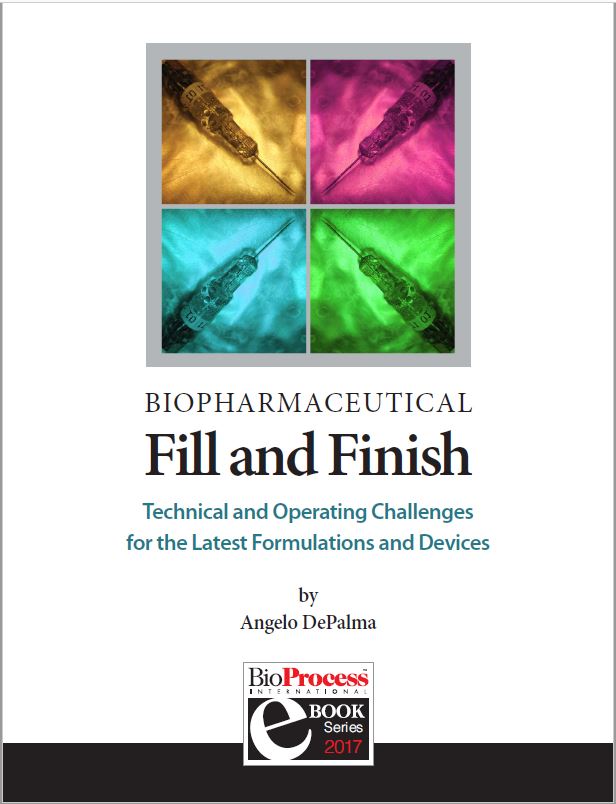 Biopharmaceutical Fill and Finish: Technical and Operating Challenges for the Latest Formulations and Devices
Biopharmaceutical Fill and Finish: Technical and Operating Challenges for the Latest Formulations and Devices
This eBook reports on the technical and operating challenges impacting the latest formulations and devices including: outsourcing, contamination, standardization (pre-filled syringes), lyophilization, and serialization. Get informed on the current state-of-the-art technologies in fill and finish to ensure your product development efforts take full advantage of the innovation in this area of biomanufacturing.

